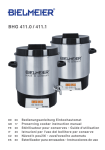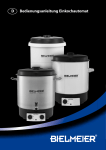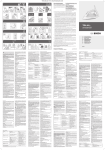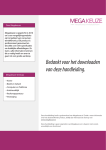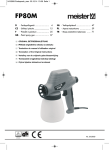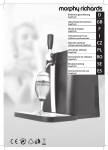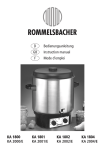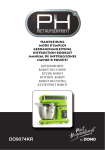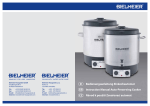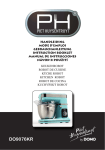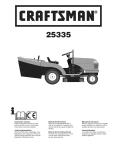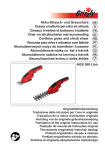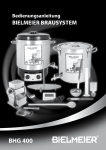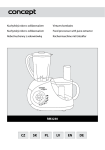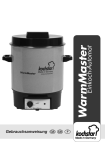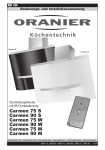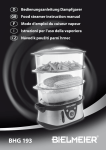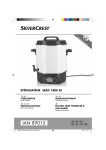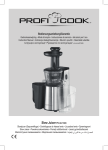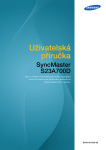Download F - Bielmeier Hausgeräte
Transcript
D Bedienungsanleitung Einkochautomat GB Preserving Cooker Instruction Manual F Stérilisateur pour conserves - Guide d‘utilisation I Istruzioni per l’uso del bollitore per conserve CZ Návod k použití zavařovacího automatu D Inhalt GB INDEX Wichtige Sicherheitshinweise . . . . . . . . . . . . . 6 Allgemeine Informationen. . . . . . . . . . . . . . . . 7 Wichtige Hinweise . . . . . . . . . . . . . . . . . . . . . . . . 7 Reinigung . . . . . . . . . . . . . . . . . . . . . . . . . . . . . . . . 7 Thermostat. . . . . . . . . . . . . . . . . . . . . . . . . . . . . . . . 7 Geräte mit Zeitschaltuhr. . . . . . . . . . . . . . . . . . . 8 Geräte mit Auslaufhahn. . . . . . . . . . . . . . . . . . . 8 Einkochen . . . . . . . . . . . . . . . . . . . . . . . . . . . . . . . . 8 Entsaften . . . . . . . . . . . . . . . . . . . . . . . . . . . . . . . . . 10 Technische Angaben. . . . . . . . . . . . . . . . . . . . . . 10 Entsaften. . . . . . . . . . . . . . . . . . . . . . . . . . . . . . . . . . 10 Rezepte. . . . . . . . . . . . . . . . . . . . . . . . . . . . . . . . . . . 11 Garantie. . . . . . . . . . . . . . . . . . . . . . . . . . . . . . . . . . . 13 Important safety instructions. . . . . . . . . . . . . . General information. . . . . . . . . . . . . . . . . . . . . . . Important instructions. . . . . . . . . . . . . . . . . . . . Cleaning . . . . . . . . . . . . . . . . . . . . . . . . . . . . . . . . . . Temperature Control. . . . . . . . . . . . . . . . . . . . . . Appliances with a timer . . . . . . . . . . . . . . . . . . . Appliances with a tap . . . . . . . . . . . . . . . . . . . . . Preserving . . . . . . . . . . . . . . . . . . . . . . . . . . . . . . . . Juice Extraction . . . . . . . . . . . . . . . . . . . . . . . . . . . Technical details. . . . . . . . . . . . . . . . . . . . . . . . . . . Caring for the environment . . . . . . . . . . . . . . . Recipes. . . . . . . . . . . . . . . . . . . . . . . . . . . . . . . . . . . . Warranty. . . . . . . . . . . . . . . . . . . . . . . . . . . . . . . . . . F TABLE DES MATIERES I Contenuto Recommandations de sécurité. . . . . . . . . . . . Informations générales. . . . . . . . . . . . . . . . . . . . Informations importantes. . . . . . . . . . . . . . . . . Entretien. . . . . . . . . . . . . . . . . . . . . . . . . . . . . . . . . . Thermostat. . . . . . . . . . . . . . . . . . . . . . . . . . . . . . . . Appareil avec minuteur . . . . . . . . . . . . . . . . . . . Appareil avec robinet de vidange . . . . . . . . . Conserves . . . . . . . . . . . . . . . . . . . . . . . . . . . . . . . . Extraction de jus . . . . . . . . . . . . . . . . . . . . . . . . . . Donnees techniques. . . . . . . . . . . . . . . . . . . . . . Conside rations ecologiques . . . . . . . . . . . . . . Recettes. . . . . . . . . . . . . . . . . . . . . . . . . . . . . . . . . . . Garantie. . . . . . . . . . . . . . . . . . . . . . . . . . . . . . . . . . . 14 15 15 15 15 16 16 16 18 18 18 19 21 22 23 23 23 23 24 24 24 26 26 26 27 29 Avvertenze di sicurezza. . . . . . . . . . . . . . . . . . . Informazioni generali . . . . . . . . . . . . . . . . . . . . . Informazioni importanti. . . . . . . . . . . . . . . . . . . Pulizia. . . . . . . . . . . . . . . . . . . . . . . . . . . . . . . . . . . . . Termostato. . . . . . . . . . . . . . . . . . . . . . . . . . . . . . . . Apparecchi con timer . . . . . . . . . . . . . . . . . . . . . Apparecchi con il rubinetto erogatore. . . . . Bollire e sterilizzare. . . . . . . . . . . . . . . . . . . . . . . . Centrifugare . . . . . . . . . . . . . . . . . . . . . . . . . . . . . . Caratteristiche tecniche. . . . . . . . . . . . . . . . . . . Tutela dell‘ambiente. . . . . . . . . . . . . . . . . . . . . . . Ricette . . . . . . . . . . . . . . . . . . . . . . . . . . . . . . . . . . . . Garanzia . . . . . . . . . . . . . . . . . . . . . . . . . . . . . . . . . . 30 31 31 31 31 32 32 32 34 34 34 35 37 Důležitá bezpečnostní opatření. . . . . . . . . . . 38 Všeobecné informace. . . . . . . . . . . . . . . . . . . . . 39 Důležitá upozornění. . . . . . . . . . . . . . . . . . . . . . . 39 Údržba. . . . . . . . . . . . . . . . . . . . . . . . . . . . . . . . . . . . 39 Termostat. . . . . . . . . . . . . . . . . . . . . . . . . . . . . . . . . 39 Zařizeni s časovym spinačem. . . . . . . . . . . . . . 40 Zařizeni svypustnymkohoutem . . . . . . . . . . . . 40 Zavařování. . . . . . . . . . . . . . . . . . . . . . . . . . . . . . . . 40 Odšťavňování. . . . . . . . . . . . . . . . . . . . . . . . . . . . . Technicke Udaje. . . . . . . . . . . . . . . . . . . . . . . . . . . Dbejte na životni prostředi. . . . . . . . . . . . . . . . Recepty. . . . . . . . . . . . . . . . . . . . . . . . . . . . . . . . . . . Záruční list. . . . . . . . . . . . . . . . . . . . . . . . . . . . . . . . 42 42 42 43 45 CZ OBSAH 3 D GB EINKOCH-VOLLAUTOMAT F STÉRILISATEUR POUR CONSERVES AUTO-PRESERVING COOKER I Bollitore per conserve automatico CZ D GB EINKOCH-HALBAUTOMAT F STÉRILISATEUR POUR CONSERVES PRESERVING COOKER I Bollitore per conserve semiautomatico ZAVAŘOVACÍ PLNOAUTOMAT 1 CZ 1 I 2 WEEE-Reg.- Nr.: DE30751975 3 Parte inferiore con elemento di ris caldamento KOMFORT FÜR JEDE JAHRESZEIT 4 Regolatore del termostato Lizenz Nr.: 5452569 5 Luce di controllo 6 Spina elettrica 3 3 40 70 20 40 100 30 90 tsa fte n 0 Dauerbetrieb 4 5 8 0 120 11 6 1 Deckel 70 7 Griglia Non inclusa in alcuni modelli. Ordinare separatamente: N. Art. 068.022. 80 Kochen En tsa fte n 8 Timer 6 7 7 D 60 90 80 Kochen En °C Min. 60 90 4 5 50 30 50 80 40 70 30 60 50 °C 1 Coperchio 2 Bollitore in: – acciaio – smalto – plastica 2 KOMFORT FÜR JEDE JAHRESZEIT 9 4 ZAVAŘOVACÍ AUTOMAT GB 1 Lid 9 Rubinetto erogatore Salvo il diritto di cambiamenti. F 1 Couvercle CZ 1 Poklice 2 Kessel aus: – Edelstahl – Emaille – Kunststoff 2 Pot made of: – Stainless steel – Enamel – Plastics 2 Cuve en : – Acier inoxydable – Émail – plastique 2 Hrnec vyroben z: – Nerezu – Smaltu – Umělé hmoty 3 Unterteil mit Heizelement 3 Bottom part with heater 3 Base avec élément de chauffage 3 Dno nádoby s topným tělesem 4 Thermostatregler 4 Temperature control 4 Bouton de thermostat 4 Regulátor teploty 5 Kontrollleuchte 5 Indicator lamp 5 Témoin de contrôle 5 Světelná kontrolka 6Netzanschlussstecker 6 Power plug 6 Prise secteur 6 Síťový kabel 7 Einlegerost ist bei einigen Modellen nicht inklusive. Bitte separat bestellen: Art.-Nr. 068.022. 7 Grating insert is not included at some models. Please order separately: article 068.022. 7 Grille non incluse avec certains modèles. Commander séparément : Réf. 068.022. 7 Rošt u některých modelů není součástí dodávky. Obj. č. 068.022. 8 Synchronzeitschaltuhr 8 Synchronized timer 8 Minuteur 8 Synchronní časovač 9 Auslaufhahn 9 Tap 9 Robinet de vidange 9 Výpustný kohout Änderungen vorbehalten. Product may be subject to change. Sous réserve de modifications. Změny vyhrazeny. 5 D D Gebrauchsanweisung für alle BIELMEIER Einkochautomaten, Einkochvollautomaten und Glühweinautomaten. WICHTIGE SICHERHEITSHINWEISE Wir freuen uns, dass Sie sich für dieses Produkt entschieden haben und bedanken uns für Ihr Vertrauen. Die Sicherheit von BIELMEIER-Elektro geräten entspricht den anerkannten Regeln der Technik und den gesetzlichen Bestimmungen. Damit Sie viel Freude an Ihrem neuen BIELMEIER Einkoch- oder Glühweinautomaten haben, bitten wir Sie, die nachfolgenden Hinweise sorgfältig zu beachten. lesen Sie die Gebrauchsanweisung vor der ersten Inbetriebnahme sorgfältig durch und bewahren Sie diese auf! Das Gerät darf nicht in Betrieb genommen werden, wenn: – die Zuleitung beschädigt ist, – das Gerät sichtbare Schäden aufweist, – das Gerät heruntergefallen sein sollte, – das Gerät außen nass oder feucht ist. Bei offensichtlichen Schäden an Gerät bzw. Zuleitung, lassen Sie das Gerät von einem Fachmann oder dem BIELMEIER Kundendienst prüfen. Das Gerät nur an Wechselstrom gemäß dem Typenschild anschließen (Schuko-Steckdose). Transportieren Sie das Gerät nur im leeren Fassungsvermögen: Der BIELMEIER Einkoch automat fasst 29 Liter. Der Flüssigkeitsstand darf bis max. 4 cm unter den oberen Rand reichen. Das Gerät nur im kalten und vollständig Das Gerät ist vielseitig verwendbar: Einkochen, Wärmen im Wasserbad, Zubereiten von heißen Getränken, Kochen*, Aufwärmen*, Blanchieren von Gemüse* usw. und kalten Zustand! Befüllt hat der Einkoch automat ein hohes Gewicht, wodurch Ver letzungsgefahr besteht! geleerten Zustand an den Griffen anheben! Bei Missachtung droht die Gefahr von Verbrühungen und / oder Verbrennungen. Dicke, zum Anbrennen neigende Speisen müssen langsam und unter ständigem Rühren erwärmt werden.* Entleeren Sie das Gerät im heißen Zustand Sollte Ihr Gerät einmal leerkochen, verhindert ein zusätzlicher Trockengehschutz Schäden am Heizelement. Lassen Sie das Gerät dann gut ab kühlen, bevor Sie es wieder befüllen. Es besteht ansonsten Verbrühungsgefahr durch Dampf bildung. Außerdem kann dadurch bei Emaille- Geräten die Oberfläche beschädigt werden. niemals durch Kippen des Gerätes. Im hei ßen Zustand ist der Inhalt ausschließlich durch den Auslaufhahn (9) zu entnehmen. Sollte dies nicht möglich sein, muss abgewartet werden bis das Gerät und der Inhalt abgekühlt sind. Beim Kippen des Geräts im befüllten und heißen Zustand besteht die Gefahr von Verbrennungen und / oder Verbrühungen. Befüllen Sie das Gerät bevor Sie es einschalten. Füllen Sie den Kessel (2) bis höchstens 4 cm unterhalb des Randes. Ein Überlaufen ist ge fährlich und kann das Gerät beschädigen. Vorsicht! Durch austretenden Dampf besteht Verbrühungsgefahr! Vorsicht, das Gerät wird im Betrieb heiß! Beim ersten Gebrauch kann Geruch entstehen, der sich aber nach kurzer Betriebsdauer verliert. Aus hygienischen Gründen sollten Sie vor dem ersten Gebrauch das Gerät mit ca. 6 Liter Wasser einmal auskochen – Thermostatregler (4) auf Entsaften stellen. Wichtige Hinweise zum Gebrauch des Gerätes Vor dem ersten Gebrauch die Innenseite des Der Netzstecker (6) ist zu ziehen: Fassen Sie daher – Edelstahl-Geräte nur mit wärmeisolierenden Topflappen an den Griffen an, – Emaille-Geräte nur an den isolierten Griffen an, – K unststoff-Geräte nur am Griffrand an. Tauchen Sie das Gerät nie in Wasser! Schützen den Topf (2) bis maximal 4 cm unterhalb des Randes. Ein Überlaufen ist gefährlich und kann das Gerät beschädigen. Wickeln Sie die Zuleitung vollständig ab. Lassen Sie jedoch die Zuleitung nie herunter hängen. – bei Störungen während des Betriebes, – vor jeder Reinigung und Pflege, – nach dem Gebrauch. Das Gerät muss auf eine stabile, ebene und freie Fläche gestellt werden. Stellen Sie Gerät und Zuleitung nie auf heiße Oberflächen oder in die Nähe von offenem Feuer, Gaskochern, etc. Achtung! Platzieren Sie Ihr Gerät dort, wo Sie es 6 Allgemeine Informationen verwenden wollen. Stellen Sie die Einkoch-Glä ser hinein und befüllen Sie das Gerät mit Wasser, wie in Abb. 1 (S. 8) angegeben. Stecken Sie erst dann den Stecker (6) in eine geerdete Steckdose. Sie ebenso die Zuleitung vor Feuchtigkeit. Kinder erkennen die Gefahr nicht, die beim Um gang mit elektrischen Geräten entstehen kann. Lassen Sie deshalb Kinder nie unbeaufsichtigt mit dem Elektrogerät und lassen Sie in Gegen wart von Kindern besondere Sorgfalt walten. Kessels (2) sorgfältig reinigen. Bitte beachten Sie hierzu den Abschnitt „Reinigung“. Vorsicht! Verbrennungsgefahr bei unsachge mäßer Handhabung! Niemals in den Kessel (2) greifen, wenn der Netz stecker (6) angesteckt ist oder vor kurzem ange steckt war. Reinigung Tauchen Sie das Gerät nie ins Wasser! Wischen Sie es bei gezogenem Stecker (6) außen feucht ab und waschen es innen aus. Etwa auftretende Kalkrückstände können Sie mit Essigwasser oder handelsüblichem Entkalker von Zeit zu Zeit be seitigen – anschließend mit klarem Wasser aus kochen! Schöpfen Sie die Reinigungsflüssigkeit ab oder lassen Sie sie über den Auslaufhahn (9) – falls vorhanden – ab. Kippen Sie das Gerät nicht! Von Zeit zu Zeit muss der Auslaufhahn (9) mit hei ßem Wasser, dem Spülmittel zugesetzt werden kann, gereinigt werden. Thermostat (4) Befüllen Sie das Gerät bevor Sie es einschalten. Überfüllen Sie den Kessel (2) nicht! Füllen Sie Flüssigkeiten, die nach Gebrauch noch im Kessel Temperatureinstellung (2) vorhanden sind, müssen abgeschöpft oder über den Auslaufhahn (9) – falls vorhanden – ab gelassen werden. Kippen Sie das Gerät nicht! Bitte beachten Sie bei Kunststoff-Geräten: Bei Zweckentfremdung oder falscher Hand Das Gerät ist ausschließlich zum Einkochen von Lebensmitteln, zum Entsaften und zur Zuberei tung von heißen Getränken gedacht. habung kann keine Haftung für evtl. Schäden übernommen werden. Im Gegensatz zu den Emaille- bzw. Edelstahl- Geräten ist der Boden des Kessels (2) nicht ge schlossen – das Heizelement liegt offen. Das Gerät ist mit einem Präzisions-Thermostat (Kapillarrohr-Regler) ausgerüstet. Der Thermo statregler (4) ist von ca. 30°C bis zum Siedepunkt stufenlos einstellbar. Die eingestellte Tempera tur wird automatisch geregelt. Ein zusätzliches Thermometer ist nicht erforderlich. Dieses Gerät ist nur für den hauswirtschaft lichen Gebrauch und nicht für den gewerb lichen Einsatz geeignet. Es ist nicht dafür geeignet dickflüssige Lebensmittel direkt im Gerät zu erwärmen bzw. zu kochen. Drehen Sie den Thermostatregler (4) nach rechts bis zum Anschlag, dann bis zur gewünschten Temperatur-Stufe zurück. Drehen Sie am Ende der Betriebszeit und bei Betriebsunterbrechungen den Thermostat regler (4) ganz nach links, entgegen dem Uhrzeigersinn und ziehen den Netzstecker (6). * Geräte aus Kunststoff sind aufgrund ihres offen liegenden Heizelements hierfür nicht geeignet. 7 D Thermostat-Einstellung „Kochen“ Die Kochtemperatur des Wassers ist vom Luftdruck bzw. von der örtlichen Höhenlage abhängig. Wird also der Thermostatregler (4) am Gerät zu hoch eingestellt, heizt das Gerät ständig und es entsteht eine starke Dampfbildung. D. h. Wasser verlust im Gerät und Energieverschwendung. So finden Sie die richtige Kochpunkteinstellung an Ihrem Gerät leicht heraus: 1 Thermostatregler (4) im Uhrzeigersinn nach rechts bis zur Kochen-Markierung drehen. 2 Kochpunkt des Wassers abwarten. 3 Thermostatregler (4) langsam nach links drehen bis sich der Thermostat ausschaltet. Das Siede geräusch wird leiser und es bildet sich weniger Dampf. In dieser Thermostateinstellung wird die Heizung automatisch ein- und ausgeschaltet. Thermostat-Einstellung „Entsaften“ Der BIELMEIER Einkochautomat eignet sich bei Verwendung des BIELMEIER Entsafteraufsatzes BHG 630 (nicht im Lieferumfang enthalten) her vorragend zum Entsaften. Natürlich können Sie auch einen anderen handelsüblichen Entsafteraufsatz verwenden (wichtig: Durchmesser 35 cm). Für den Entsafterbetrieb besitzt der Thermostat regler (4) zusätzlich eine Markierung, die eine durchgehende Beheizung gewährleistet. Geräte mit Zeitschaltuhr (8) Um den Einkochvorgang gemäß Kochbuch oder Tabelle zu begrenzen, haben wir in das Gerät ei ne elektrische Synchron-Zeitschaltuhr (8) einge baut. Diese Zeitschaltuhr (8) hat 2 Betriebsarten: 1 Dauerbetriebsstufe (Drehknopf (8) nach links, entgegen dem Uhrzeigersinn gedreht). 2 Automatikbereich, stufenlos einstellbare Zeit von 20 – 120 Minuten (Drehknopf (8) nach rechts, im Uhrzeigersinn gedreht). In der Dauerbetriebsstufe schaltet die Zeit schaltuhr (8) nicht automatisch ab. Diese Schalt stellung benötigen Sie zum Entsaften oder zum Warmhalten von Speisen* / Getränken (länger als 2 Stunden). 8 D Beim vollautomatischen Einkochen stellen Sie den Thermostatregler (4) auf die Temperatur gemäß Einkochtabelle, die Zeitschaltuhr (8) auf die nötige Einkochzeit. Nun beginnt der automatische Ein kochvorgang, die Kontrollleuchte (5) leuchtet. Erst wenn die eingestellte Temperatur erreicht ist, wird die Zeitschaltuhr (8) automatisch in Betrieb gesetzt und läuft in der eingestellten Zeit zurück. Nach Ablauf der Zeit erlischt die Kontrollleuchte (5). Geräte mit Auslaufhahn (9) Sie können dünne Flüssigkeiten durch den Auslaufhahn (9) entnehmen. Bei der Zubereitung dick flüssiger Speisen* empfehlen wir, um eine Verstop fung zu vermeiden, den Hahnanschluss im Innern des Gerätes, z. B. mit einem Stopfen, abzudichten. Reinigen Sie Gläser, Dosen und Flaschen zuerst sorgfältig mit heißem Spülwasser. Spülen Sie sie anschließend klar nach und lassen sie auf einem sauberen Tuch abtropfen. Prüfen Sie alle Gefäße auf anhaftende Reste und Beschädigungen. Reinigen Sie die Verschlüsse ebenfalls sorg Befüllen Sie die Gefäße wie folgt: Zweckmäßig ist die Beschriftung der Gläser, – bei Wurst aller Art, das Gefäß nur ¾ füllen, –b ei nachquellendem Einkochgut (z. B. Ku chenteig) nur bis zu ½ Glashöhe füllen. Vorab sei gesagt: gegenüber Omas Einkochre geln hat sich nichts geändert! –B eachten Sie bitte auch die jeweiligen Hin weise beim Gläserkauf. Einkochen bedeutet Sterilisieren des Einmach gutes ohne chemische Konservierungsstoffe. Die erzeugte gleichmäßige Hitze tötet die im Einmachgut vorhandenen Keime; gleichzeitig wird durch den entstehenden Unterdruck das Einmachglas keimfrei und luftdicht verschlossen. Verschließen Sie die Gefäße fest mit Klammern, Schraub- oder Spannverschlüssen. Stellen Sie die Gläser immer auf den Einlege rost (7). Sie können auch unterschiedlich hohe Gläser verwenden. Nur . . . der Einkoch-Topf ist nicht mehr derselbe wie zu Omas Zeiten! BIELMEIER Einkochauto maten bringen Ihnen viele Erleichterungen, die Oma auch gerne gehabt hätte! Obst und Gemüse sollten von guter Qualität, frisch und optimal gereift sein. Waschen Sie Obst und Gemüse unzerkleinert und lassen Sie es abtropfen. Grüne Bohnen und Erbsen sind haltbarer, wenn sie vorher blanchiert werden. * Geräte aus Kunststoff sind aufgrund ihres offen liegenden Heizelements hierfür nicht geeignet. Entnehmen Sie die Gläser. Lassen Sie die Klam Eingemachtes bewahren Sie am besten an und überdehnten Gummiringe oder -kappen. – b ei breiartigem Einmachgut (z. B. Apfelmus) 3 – 4 cm bis zum Glasrand frei lassen, Haltbarkeitsgründen oberstes Gebot. Netzstecker (6). Verwenden Sie keine porösen, beschädigten Vorbereitung und Sauberkeit sind aus Ziehen Sie nach Ablauf der Einkochzeit den mern bis zur vollständigen Abkühlung auf den Gläsern. Dosen müssen sofort in kaltes Wasser gelegt werden. –g rundsätzlich das Einkochgut nur bis ma ximal 2 cm unter den Rand füllen, Einkochen – So funktioniert’s! Die Einkochzeit beginnt erst dann, wenn die gewählte Temperatur erreicht ist. fältig mit heißem Spülwasser und lassen Sie sie bis zum Gebrauch in klarem Wasser liegen. Wissenswertes zum Einkochen Die Aufheizzeit zählt nicht zur Einkochzeit. (Abb. 1) Die Gläser sollen zu 2⁄3 bis ¾ im Wasser stehen; bei Doppelbelegung also die obere Lage. Die optimale Wasserfüllhöhe: Beim Einsetzen der Gläser soll die Wasser temperatur etwa gleich der Gläsertemperatur sein. Dies spart Energie und Zeit. Setzen Sie den Deckel (1) auf den Kessel (2). Stecken Sie das Gerät ein. Entnehmen Sie die Einkochtemperatur und -zeit dem Rezept bzw. Einkochbuch und stellen Sie sie bei Ihrem BIELMEIER Einkochautomaten ein. einem trockenen, kühlen und dunklen Ort auf. Dosen usw. (mit Datum und Inhalt). Wie und auf welche vielfältigen Arten Sie Obst, Gemüse, Fleisch etc. einkochen können, ent nehmen Sie bitte Ihren Kochbüchern. Sehen Sie hierzu auch unsere Rezeptbeispiele auf S. 10. Einkochtabelle Obst Temp. Johannisbeeren 85°C Äpfel, Birnen 90°C Erdbeeren 75°C Heidelbeeren 85°C Himbeeren, Stachelbeeren 80°C Kirschen, Mirabellen 85°C Pfirsiche, Aprikosen, 90°C Zwetschgen Rhabarber kochen Zeit 20 Min. 30 Min. 25 Min. 25 Min. 30 Min. 30 Min. 30 Min. 30 Min. Gemüse Blumenkohl Bohnen, Erbsen Dicke Bohnen Essig-Gurken Karotten, Möhren, Kohlrabi Kürbis Rosenkohl, Wirsing, Spargel Tomaten Temp. Zeit kochen 90 Min. kochen 120 Min. kochen 90 Min. 90°C 30 Min. kochen 90 Min. 90°C 30 Min. kochen 120 Min. 90°C 30 Min. Fleisch Bratenstück, vorgebraten Gulasch, angebraten Wild / Geflügel, angebraten Wurstmasse Temp. Zeit kochen 75 Min. kochen 75 Min. kochen 75 Min. kochen 120 Min. 9 D D Hinweis: Diese Angaben sind Richtwerte. Die Zeiten gelten erst ab dem Erreichen der jewei ligen Temperatur. Großmutters Rezepte behalten auch bei Einkochautomaten bzw. Einkochvollau tomaten ihre Gültigkeit. Entsaften Sie benötigen hierfür den BIELMEIER Entsafter aufsatz BHG 630 (nicht im Lieferumfang enthal ten) oder einen anderen handelsüblichen Ent safteraufsatz mit einem Durchmesser von 35 cm. Drehen Sie die ggf. vorhandene Zeitschaltuhr (8) nach links auf „Dauerbetrieb“. Stellen Sie bei Betriebsende den Thermostat regler (4) auf 0 und ziehen Sie den Stecker (6) Ihres Einkochautomaten. Wichtig: Vor jedem neuen Entsaftungsvorgang muss Wasser nachgefüllt werden! Rezepte Äpfel Zuckerzugabe Für süße Äpfel: 300 – 400 g Zucker auf 1 Liter Wasser Für saure Äpfel: 500 – 600 g Zucker auf 1 Liter Wasser Zubereitung Die Äpfel werden geschält, geviertelt und vom Kerngehäuse befreit. Die Apfelstücke danach sofort in kaltes Wasser legen. Damit die Früchte nicht anlaufen und braun werden, werden einige Tropfen Zitronensaft hinzugefügt. Nebenher können Sie die Zuckerlösung laut an gegebenem Verhältnis am Herd aufsezten. Danach die Früchte in die Gläser füllen, mit der aufgekochten Zuckerlösung übergießen und 30 Minuten bei 90°C einkochen. Entsafteraufsatz Einkochautomat . . . bisher . . . heute (Abb. 2) Erdbeer-Himbeer-Konfitüre Füllen Sie in den Einkochautomaten mindes tens 6 Liter Wasser. Setzen Sie den Entsafteraufsatz, wie in Abb. 2 gezeigt, auf den Kochautomaten. Geben Sie das vorbereitete Obst, Gemüse, etc. in den Fruchtkorb – füllen Sie ihn jedoch nicht mehr als bis zu ¾. Weitere Details zum Vorbereiten des Entsaftungsguts entnehmen Sie bitte der Bedienungsanleitung Ihres Ent safteraufsatzes oder Ihren Kochbüchern. Zutaten Zubereitung 500 g Zucker 750 g Erdbeeren 500 g Himbeeren Saft einer halben Zitrone Die Himbeeren sorgfältig verlesen und durch ein Sieb streichen. Die Erdbeeren, das Himbeermark und den Zucker vermischen und einige Zeit zie hen lassen. Danach den Zitronensaft hinzufügen. Setzen Sie den Deckel (1) auf den Entsafterauf satz und vergewissern Sie sich, dass er sauber schließt. Ansonsten wird Energie verschwen det, da der Dampf entweichen kann. Karotten Stecken Sie den Stecker (6) Ihres Einkochauto maten in eine Schukosteckdose. Info: Unbedingt vor dem Einkochen vorkochen! Drehen Sie den Thermostatregler (4) ganz nach rechts bis zur Markierung „Entsaften“. Achtung! Erhitzungsdauer variiert: für Karotten in Scheiben oder Würfel: 90 Minuten bei 100°C Technische Angaben Stromquelle: 220 – 240 V ~ / 50 Hz 2000 W (Kunststoff und Emaille) Anschlusswert: 1800 W (Edelstahl) Kesselvolumen: 29 Liter 10 Dieses Gerät entspricht den Richtlinien Nr. 89/336/ EWG für elektromagnetische Verträglichkeit (EMV), sowie der Niederspannungsrichtlinie 73/23 EWG. Die Fruchtmischung unter Rühren zum Kochen bringen und bis zur Gelierprobe (1 TL Konfitüre auf einen kalten Porzellanteller geben – geliert es innerhalb kurzer Zeit, so ist es fertig) kochen. Die Konfitüre in die Einkoch- oder Schraubgläser füllen und diese sofort verschließen und 10 Minuten bei 90°C einkochen. Der Umwelt zuliebe Werfen Sie Verpackungsmaterial und ausgediente Geräte nicht einfach weg, sondern führen Sie sie der Wiederverwertung zu. Den zuständigen Recyclinghof bzw. die nächste Sammelstelle erfragen Sie bitte bei Ihrer Kommunalverwaltung. Zur Inanspruchnahme von Garantieleistungen wenden Sie sich bitte an Ihren Händler oder die BIELMEIER Kundendienstzentrale Ihres Landes. für ganze Karotten: 120 Minuten bei 100°C Zubereitung Schneidet man die Karotten in Scheiben oder Würfel, so eignen sich dazu besonders junge, aber nicht zu kleine Karotten, deren Aroma und Zartheit die große Mühe der Vorbereitung rechtfertigen. Nachdem das Kraut von den Karotten abge schnitten wurde, schabt man die obere Haut mit einem Gemüsemesser ab und legt sie sofort in frisches Wasser, damit die schöne Farbe nicht verblasst. Danach die Karotten in Scheiben oder Würfel schneiden und in einem Topf etwa 5 Mi nuten vorkochen. Nun schreckt man sie mit kal tem Wasser ab, füllt sie in die Gläser, übergießt sie mit einer leichten, aufgekochten Salzlösung und kocht die Karotten 90 Minuten bei 100°C ein. 11 D D GARANTIE Kalbsrouladen Info: Unbedingt vor dem Einkochen vorbraten! Zutaten für 4 – 6 Portionen 700 g Kalbskeule (ca. 4 – 6 Schnitzel mit je 120 – 150 g) 2 Zwiebeln 50 g Gewürzgurken 50 g magerer Katenschinken 2 – 3 El mittelscharfer Senf Salz und Pfeffer 2 El Öl 400 ml Kalbsfond Zubereitung Die Schnitzel evtl. flach klopfen. Zwiebeln, Gur ken und Schinken fein würfeln. Alles mit dem Senf zu einer glatten Masse verrühren. Die Rouladen mit Salz und Pfeffer würzen und die Masse jeweils mittig darauf verteilen. Die Seiten einschlagen, die Rouladen fest aufrollen und mit einem Faden umbinden oder mit Hilfe einer feinen Spicknadel die Rouladen durch länglich geschnittene Speckstreifen zusammenhalten. Das Öl in einem Schmortopf erhitzen und die Rouladen darin rundherum scharf anbraten. Mit Kalbsfond ablöschen und zugedeckt bei mittlerer Hitze garschmoren. Anschließend die Fäden oder Spicknadeln ent fernen, die Rouladen in Gläser legen, mit der Bra tensoße bis 3 cm unter den Glasrand übergießen und 75 Minuten bei 100°C einkochen. Rosinen-Hefe-Kuchen im Glas Zutaten Zubereitung 500 g Mehl 1⁄8 – ¼ Ltr. Milch 3 – 4 Eier 80 g Zucker 12 g frische Hefe oder Mit lauwarmer Milch die Hefe anrühren, die ge schmolzene, lauwarme Butter, Salz, Zucker und die Eier zugeben und alles miteinander vermi schen. Das Mehl übersieben und unterrühren. Den Teig kneten und abschlagen. Über Nacht den Teig zugedeckt stehen lassen. ½ Päckchen Trockenhefe etwas Salz 150 g Butter 200 g Rosinen Am nächsten Tag wird der Teig nochmals gekne tet, bis er sich von der Schlüssel löst, dabei wer den die Rosinen schnell eingearbeitet. Anschließend die Sturzgläser gut einfetten und mit Paniermehl oder gemahlenen Nüssen aus streuen. Die Gläser bis zur Hälfte mit der Teigmasse füllen, dann noch einmal kurz gehen lassen. Verschließen Sie die Gläser mit Deckel und Klam mern. Backen und Einkochen geschieht gleichzei tig im Heißwasserbad für 120 Minuten bei 100°C. 12 en Wir wu“ nschen Ihnen viel Vergnu“ g ochautomaten! mit Ihrem Bielmeier Eink Für die am Verkaufstag beginnende Garantie gelten innerhalb der EU und der Schweiz folgende Bestimmungen: 1.Garantiedauer: 2 Jahre 2.Garantieleistungen: a) Nach unserer Wahl Reparatur oder Aus tausch von Teilen, die nach unserer Über prüfung Material- oder Fertigungsfehler aufweisen. b) Die Garantie wird nur bei Vorzeigen dieser Garantiekarte und der Verkaufsrechnung geleistet. Die Karte ist nur gültig, wenn sie am Verkaufstag vollständig ausgefüllt wurde. c) Die Garantieleistung gilt nur gegenüber dem Erstverbraucher. d) Durch die Reparatur oder den Austausch von Teilen innerhalb der Garantiedauer wird die ursprüngliche Garantiezeit weder verlängert noch erneuert. e) Transportkosten gehen zu Lasten des Käu fers (gilt nicht für die ersten 6 Monate der Garantiezeit). f) Sofern der Schaden oder Mangel nicht be seitigt werden kann oder die Nachbesse rung von uns abgelehnt oder unzumutbar verzögert wird, wird innerhalb von 6 Mona ten ab Kauf-/Lieferdatum auf Wunsch des Endabnehmers entweder kostenfrei Ersatz geliefert oder der Minderwert vergütet oder das Gerät gegen Erstattung des Kaufpreises, jedoch nicht über den marktüblichen Preis hinaus, zurückgenommen. 3. Die Garantie gilt nicht: Für Kratzer und Flecken am Gerät. Für Beleuchtungs- und Kontrolllampen. Für leicht zerbrechliche Teile aus Bakelit, Glas, Plastik und so weiter, es sei denn, es handelt sich um Materialfehler, die von uns als solche anerkannt werden. Für Beschädigungen, die durch falsche Instal lation oder Befestigung verursacht wurden. Wenn das Gerät an ein Stromnetz mit hö herer Spannung, als auf dem Gerät angege ben, angeschlossen wird. Bei falscher oder unsachgemäßer Bedie nung. Bei mangelnder Sorgfalt. Bei ungenügender oder falscher Wartung. Bei Fallenlassen des Gerätes oder einzelner Teile. Bei unsachgemäßem Transport oder unsach gemäßer Verpackung für den Transport. 4. Die Garantie erlischt: Wenn das Gerät für andere als für Haushalts zwecke eingesetzt wird. Wenn Personen, die nicht von unserer Firma dazu ermächtigt sind, Reparaturen oder Än derungen durchführen. Für dieses Gerät leisten wir 2 Jahre Garantie für Mängel, die auf Fertigungs- oder Materialfehler zurückzuführen sind. Die Garantiezeit beginnt mit dem Tag der Übergabe und wird nur bei Vorlage der Garantiekarte und der Verkaufsrechnung gewährt. Weitergehende Ansprüche bestehen nicht. Modell: Stempel und Unterschrift des Verkäufers Wichtig! Bitte notieren Sie hier den auf dem Typenschild am Gerät befindlichen FD-Code: Verkaufsdatum 13 GB GB Instruction manual General information for all BIELMEIER preserving cookers, fully automatic preserving cookers and wine cookers IMPORTANT SAFETY INSTRUCTIONS We're delighted that you've chosen our product and we thank you for your business! The safety of all electronic appliances from BIELMEIER com plies with generally accepted technical standards and with safety legislation. Before you start enjoying your new BIELMEIER preserving cooker, please read the following in formation carefully: Read the instructions carefully before using the appliance for the first time and keep these instructions in a safe place. Do not use the appliance if: – the mains cable is damaged, – the appliance is visibly damaged, – the appliance has previously been dropped, – the appliance is wet outside. If the appliance or mains cable are visibly dam aged, please have your appliance checked by an expert or by customer service. Only connect this appliance to an AC power outlet as specified on the appliance's rat ing plate (Schuko (Type F) socket – using an adapter if required). Unwind the mains cable fully before use. Never leave the mains cable dangling. Unplug the appliance from the mains: – if any fault occurs during operation – before cleaning and servicing – after each use Position the appliance in an unobstructed space on a stable, level surface. Never place the appliance or mains cable on a hot surface or near an open flame, e. g. gas cooker. Attention! Place the appliance in the position 14 in which it is to be used. Insert the preserving jars and fill the appliance with water, as shown in Fig. 1 (page 16). Only insert the mains plug into an earthed socket after this step. Move the appliance only, when it’s empty and cold! Filled, the preserving cooker has a high weight, which may cause injuries! Just raise the appliance at the handles, if it’s cold and empty! Danger of scalding and / or burns by non-obervance. Never empty the preserving cooker, if it’s hot by tilting the device. If the appliance is hot, just emty it through the tap. If this is not possible, you have to wait until the appliance and the contents have cooled off. Danger of scalding and / or burns, when tilting the device in hot and filled state. Fill the appliance before switching it on. Do not fill container to a level higher than 4 cm below the rim. Hot water may spurt out if the pot is overfilled. Caution! Risk of scalding due to escaping steam! Caution! The appliance becomes hot when in Capacity: The BIELMEIER preserving cooker has a capacity of 29 litres. The level of liquid in the cook er must be no higher than 4 cm below the rim. The appliance can be used in many different ways: preserving, heating in a water bath, prepar ing hot drinks, cooking*, reheating*, blanching vegetables*, etc. Thick food that tends to burn easily requires slow, constant stirring.* If your appliance ever boils dry, an additional dry-running protection feature prevents dam ages at the heating element. Allow the appli ance sufficient time to cool down before refilling it with water. This avoids the risk of scalding due to steam formation. Steam can also damage the surfaces of appliances made with enamel. An odor may develop for a short time the first time you use the appliance. For reasons of hygiene, fill the appliance with approx. 6 litres of water – set the temperature control switch (4) to the “Entsaften” (juice making) setting – and bring to the boil before you use the appliance for the first time. Important instructions for using use! For this reason, only take hold of – stainless steel appliances by the handles while wearing a heat-insulating oven mitt. – enamel appliances by their insulated handles. – plastic appliances by the handle rims. Never immerse the appliance in water! Similar ly, do not expose the mains cable to moisture. Children are unaware of the possible dangers as sociated with electrical appliances. For this rea son, never leave a child alone and unsupervised with the appliance and be extra vigilant when using the appliance when children are around. This appliance is designed for household use Carefully clean the inside of the pot (2) before using the appliance for the first time. For more information, refer to the “Cleaning” section. Fill the appliance with water before switching it on. Take care not to overfill the pot (2)! Fill the pot (2) to a level no higher than 4 cm below the rim. Hot water may spurt out if the pot is overfilled. If liquids still in the pot (2) after use, you have to skim it or drain it by the tap (9) – if available. Never tilt the device! only and is not suitable for commercial use. The manufacturer accepts no liability for pos sible damages in cases where the appliance is used incorrectly or for purposes other than those for which it is intended. Please note for the plastic version: The appliance is designed to be used for preserving food, making juice and preparing hot drinks only. Do not heat or boil foods with a thick, viscous consistency in the appliance directly. Unlike the enamel and stainless steel versions, the plastic appliance has an open bottom and the heating element is uncovered. Caution! Risk of scalding and / or burns, when improper use! Never grasp into the pot (2), if the appliances is plugged or if was running a short time ago. Cleaning Never immerse the appliance in water! Un plug from the mains, wipe down the exterior and wash out the interior. Limescale deposits can be removed by regular descaling with a mixture of vinegar and water or a commercial descaler, followed by boiling of a pot full of clean water. Skim cleaning emulsion in the pot (2) or drain it by the tap (9) – if available. Never tilt the device! Clean the tap (9) occasionally with hot water, which can be mixed with a cleaning agent. Temperature control (4) The appliance is equipped with a precision ther mostat (capillary tube thermostat). The tem perature control switch (4) allows you to set infi nitely variable temperatures from approx. 30° C to boiling point. The temperature selected is regulated automatically and no additional ther mometer is required. Setting the temperature Turn the temperature control switch (4) all the way to the right until it stops and then back to the desired temperature. Turn the temperature control switch (4) all the way to the left (counter-clockwise) and unplug the appliance from the mains each time you finish using the cooker or if a failure occurs during operation. * Plastic appliances are not suitable for this purpose because of their exposed heating element. 15 GB The “Kochen” (boiling) thermostat setting The boiling point of water depends on atmos pheric pressure and altitude. If the temperature control switch (4) on the ap pliance is set to high, the cooker will boil continu ously and a large amount of steam will develop, resulting in water loss and wasted energy. To find the correct temperature setting for boiling water on your appliance, follow the steps below: 1 Turn the temperature control switch (4) all the way to the right until it reaches the “Kochen” (boiling) setting marked on the appliance. 2 Wait for the water to boil. 3 Slowly turn the temperature control switch (4) to the left until the thermostat switches off. The sound of boiling will become less audible and less steam will develop. The heating ele ment is activated and deactivated automati cally at this thermostat setting. The “Entsaften” (juice making) thermostat setting The BIELMEIER preserver cooker is ideal for mak ing juice when used in combination with the BIELMEIER juice extraction top BHG 630 (not in cluded). Of course, other standard juice extrac tion tops can also be used (note: the top must have a diameter of 35 cm). The temperature control switch (4) has an addi tional setting that you can use when making juice to ensure continuous heating. Appliances with a timer (8) The appliance is equipped with an electric synchro nized timer (8), which allows you to regulate the preserving process specified in your cookery books or in the table below. This timer (8) has two settings: 1 Continuous mode (turn the dial to the left). 2 Automatic mode, in which you can set infinitely variable operation times from 20 – 120 minutes (turn the dial to the right). If you select the “Dauerbetrieb” setting (continuous mode), the timer does not switch off automatically. 16 GB This setting is required for juice extraction or for keeping food* / drinks warm (for more than 2 hours). For fully automated preserving, set the tempera ture control switch (4) to the required tempera ture as specified in the preserving chart below. Turn the timer dial (8) to select the required pre serving time. The automatic preserving process begins and the indicator lamp (5) lights up. When the selected temperature is reached, the timer (8) starts automatically and counts down from the selected time to 0. The indicator lamp (5) goes out once this countdown is completed. clean cloth to dry. and for damage. Wash the seals in hot soapy water and then leave them in clean water until they are needed. Do not use any porous, damaged or stretched rubber rings or rubber caps. To fill the containers: – T he containers should only ever be filled up to 2 cm at most below the mouth of the jar. –F or foods with a mushy consistency (e. g. apple sauce), leave 3 – 4 cm headspace between the top of the preserve and the mouth of the jar. Appliances with a tap (9) Thin liquids can be poured from the pot through the tap (9). To avoid blockages occurring when preparing foods with a thick, viscous consis tency*, we recommend that you seal off the tap from inside the appliance, e.g. with a plug. All you need to know about preserving First things first: Grandma's rules for canning and preserving still hold true! Preserving simply means sterilizing without chemical preserving agents. The even heat that is generated kills bacteria in the food, while, at the same time, the resulting vacuum enables air-tight, sterile sealing of the preserving jar. But . . . the preserving pot has come quite a way since Grandma's day! BIELMEIER preserving cook ers make things so easy that Grandma would have been glad to have one of her own! Preserving – how it’s done! Preparation and cleanliness are of the utmost importance when preserving food. Choose fresh, ripe, high-quality fruit and vegetables. Wash fruit and vegetables whole and leave to dry. Green beans and peas keep for longer if they are blanched first. Carefully wash jars, cans and bottles in hot water, rinse them clear and leave them on a * Plastic appliances are not suitable for this purpose because of their exposed heating element. The time taken for the cooker to heat up does Check all containers for any stubborn residues – F or sausages of any kind, only fill the con tainer ¾ full. – F or foods that will swell during the preserv ing process (e.g. cake mixture), only fill the container up to ½ full. –P lease also note the instructions provided by the jar manufacturer. Seal the containers tightly with screw-caps, fasteners or clamps. Always place the jars on the grating insert (8) when putting them into the cooker. Different sized jars can be used. (Fig. 1) Ensure that the glasses are 2⁄3 to ¾ submerged in the water. If you are using two levels of jars, this applies to the upper level. The optimal water fill levels: The water temperature should be roughly the same as the temperature of the jars when you place them in the cooker. This saves both time and energy. Place the lid on the pot. Connect the appliance to the mains. Check your recipe or the preserving chart for the required preserving temperature and time and make the corresponding settings on your BIELMEIER preserving cooker. not count as part of the preserving time. The preserving time does not start until the se lected temperature is reached. Unplug the appliance once the preserving pro cess is complete. Remove the jars. Leave the clamps on the jars until they have cooled down completely. At this point, place the jars immediately in cold water. Your preserves are best stored in a cool, dry and dark place. It is useful to label each container with the date and its contents. Refer to your cookery books for information and ideas on preserving fruit, vegetables, meat, etc. For some ideas, why not check out our recipe section on page 18. Preserving chart Fruit Temp. Redcurrants 85°C Apples, pears 90° C Strawberries 75° C Blueberries 85° C Raspberries, gooseberries 80° C Cherries, yellow plums 80° C Peaches, apricots, damsons 90° C Rhubarb Boil Time 20 mins. 30 mins. 25 mins. 25 mins. 30 mins. 30 mins. 30 mins. 30 mins. Vegetables Cauliflower Beans, peas Broad beans Gherkins Carrots, turnip cabbage Pumpkin Brussels sprouts, asparagus, savoy cabbage Tomatoes 30 mins. Temp. Time Boil 90 mins. Boil 120 mins. Boil 90 mins. 90° C 30 mins. Boil 90 mins. 90° C 30 mins. Boil 120 mins. 90° C Meat Temp. Time Large meat cuts, precooked Boil 75 mins. Goulash, precooked Boil 75 mins. Game and poultry, precooked Boil 75 mins. Sausage meat Boil 120 mins. 17 GB GB Notes: These temperatures and times are only provided as guidelines. The times specified start when the corresponding temperatures are reached. Grandma's recipes will work just as well with your preserving cooker. Juice extraction To use the juice extraction function, you will need the BIELMEIER juice extraction top 630 (not in cluded) or another standard juice extraction top with a diameter of 35 cm. If your cooker has a timer (8), turn it to the left until you reach the "Dauerbetrieb" (continu ous mode) setting. When you have finished using the cooker, re turn the temperature control switch (4) to 0 and unplug your preserving cooker. Important: Your cooker needs to be refilled each time you use the juice extraction function! Recipes Apple preserve Sugar To prepare For sweet apples: Peel and quarter the apples, and remove the cores. Immediately cover the apple pieces with cold water. Add a few drops of lemon juice to prevent browning. Add 300 – 400 g of sugar to 1 litre of water For sour apples: Add 500 – 600 g of sugar to 1 litre of water Next, fill your jars with the fruit and pour over the boiled sugar solution. Finally, leave to cook in your preserving cooker for 30 minutes at 90°C. Juice Extractor AutoPreserving Cooker . . . up to now At the same time, mix the sugar solution in the specified concentration and bring to the boil on the stove. . . . today (Fig. 2) Strawberry and raspberry preserve Fill the preserving cooker with at least 6 litres of water. Place the juice extraction top on the preserv ing cooker, as shown in Fig. 2. Place the prepared fruit, vegetables, etc. in the fruit basket, taking care not to fill it more than ¾ full. For more information about preparing the items for juicing, refer to instructions with your juice extraction top or your own cookery books. Ingredients To prepare 500 g sugar 750 g strawberries 500 g raspberries Juice of half a lemon Carefully sort the raspberries and press them through a sieve. Mix the strawberries, raspberry pulp and sugar, and leave the mixture standing for a short time. Next, add the lemon juice. Place the lid on the juice extraction top and make sure that it is closes tightly. Otherwise, energy will be wasted due to escaping steam. Plug your preserving cooker into a Schuko Bring the fruit mixture to the boil, stirring con stantly and then boil until it passes "the set test" (i.e. put 1 tsp of the preserve on a cold china plate – if it sets quickly, it's ready!). Fill your preserving jars or screw-top jars with the jam, seal immedi ately and leave to cook in your preserving cooker for 10 minutes at 90°C. socket (Type F) (use an adapter if required). Turn the temperature control switch (4) to Home-canned carrots the right until you reach the "Entsaften" (juice making) setting. Info: Carrots must be preboiled before preserving! To prepare Caution! Cooking times vary: When slicing or dicing carrots, it pays to choose the youngest carrots that are not too small. These are the most flavorsome and tender, which will make the extra effort worthwhile. for sliced or diced carrots: Technical Details Power source: 220 – 240 V ~ / 50 Hz Connected load:2000 W (plastic und enamel) 1800 W (stainless steel) Capacity of pot: 29 litres 18 This appliance conforms with EU Directive 89/336/ EEC on Electro-Magnetic Compatibility (EMC) and with the Low-Voltage Directive 73/23 EEC. Caring for the environment Please do not simply throw away packaging and disused appliances. These can be recycled. Con tact your local authority for details of the relevant recycling centre or the nearest collection point. To claim warranty, please contact your retailer or your local BIELMEIER customer service center. 90 minutes at 100°C for whole carrots: 120 minutes at 100°C Remove the foliage from the carrots, peel the outer layer of skin with a vegetable peeler, and immediately place the carrots in fresh water so that they lose none of their colour. Next, slice or dice the carrots and boil them in a saucepan of water for approx. 5 minutes. Then quench with cold water, fill the jars, pour over a mild salt so lution (boiled) and leave the carrots to cook for 90 minutes at 100°C in your preserving cooker. 19 GB GB WARRANTY Veal roulades Info: M eat must be precooked to rare before preserving! Makes 4 – 6 portions 700 g veal leg (approx. four – six 120 – 150 g cutlets) 2 onions 50 g gherkins 50 g lean smoked ham 2 – 3 tbsp medium-hot mustard Salt and pepper 2 tbsp oil 400 ml veal stock To prepare Flatten the veal cutlets if necessary. Finely dice the onions, gherkins, and ham. Add the mustard and stir together until the mixture reaches a smooth consistency. Season the veal cutlets with salt and pepper and spread an equal portion of your prepared mixture down the center strip of each cutlet. Fold in the sides of each cutlet, and tightly roll up the roulades and tie with string. Alternatively, use a thin larding needle to hold the roulades together with strips of the bacon cut lengthwise. Heat the oil in a stewing pot, add the roulades and sear them on all sides. Pour in veal stock to deglaze the pan, and then cover and stew on me dium heat until tender. Remove the string or larding needles, place the roulades in jars, cover with the gravy up to 3 cm below the rim and leave to cook in your preserv ing cooker for 75 minutes at 100°C. Ingredients To prepare 500 g flour 1⁄8 – ¼ litre of milk 3 – 4 eggs 80 g sugar 12 g fresh yeast Mix the yeast with lukewarm milk. Add the melt ed, lukewarm butter, the salt, sugar and eggs and mix well. Sieve in the flour and stir it into the mix ture. Knead and work into soft dough. Cover and leave to stand overnight. Pinch of salt 150 g butter 200 g raisins The following day, knead the dough again until it comes away from the sides of the bowl. Then quickly work in the raisins. Next, grease your wide-mouthed canning jars well and line with a layer of breadcrumbs or ground nuts. Fill each jar half-full with the dough mixture and leave to prove for a short time. Seal the jars with the lids and clips. You can bake and preserve these cakes at the same time using the hot water bath method by leaving them in your preserving cooker for 120 minutes at 100°C. 20 1.Warranty period: 2 years 2. Conditions of warranty: a) Parts which exhibit defects in material and/or workmanship after our inspection will either be repaired or replaced at our discretion. b) The warranty will only be honoured upon presentation of this warranty card and purchase receipt. This warranty is only valid if it is filled out on the date of sale and in a complete and appropriate manner. c) This warranty is only valid for the first owner of the device. d)No replacement or repair of parts perfor med within the warranty period shall provi de grounds for any extension of the original warranty period. e) Any transportation costs shall be borne by the purchaser (this shall not apply during the first 6 months of the warranty). Jar-baked raisin wheat cakes or ½ packet of dried yeast In the EU and Switzerland, the following conditions apply for the warranty, which begins on the date of purchase of the product: Enjoy using your Bielmeier preserving cooker! f) Within the first 6 months after the purchase/ delivery of the device, if the damage or de fect cannot be eliminated, if we refuse to repair the defect, or in the event of a delay in our repairing of the device, then the end user can choose from one of three options: the device will be replaced free of charge, its value will be reimbursed, or the device will be taken back with a refund of the original purchase price which shall not exceed the usual market price. 3.The warranty does not apply to: spots and scratches on the device control lamps and lights motor brushes easily breakable parts (e. g. bakelite, plastic, glass), even in the case of defects in material as recognized by us damage due to improper installation or im proper repair damage caused by an inappropriate vol tage supply or an inappropriate electricity network improper or inappropriate use of the equipment unsatisfactory care damage caused by incompetent or insufficient maintenance damage caused by dropping the equipment or part thereof improper transportation or insufficient packaging during transportation 4.The warranty shall be deemed void: in the case of use or application of the device for something other than its intended use for household purposes. in the case of any servicing or repairing of the device performed by third parties that have not been authorized for such purpose by our company. A 2-year warranty is provided for damage caused by defects in material or workmanship. The warranty period shall begin on the day of delivery or on the day the buyer takes possession of the item, and the warranty will only be honoured upon presentation of the warranty card and the purchase receipt. No further claims shall be granted. Model: Stamp and signature of salesperson Important! Please write down the FD-code located on the rating plate here: Date of sale 21 F F Mode d'emploi Informations générales des stérilisateurs de conserves, stérilisateurs automatiques et machines à boissons chaudes BIELMEIER RECOMMANDATIONS DE SÉCURITÉ Nous sommes heureux de votre achat et vous re mercions de votre confiance. La sécurité des appa reils électriques BIELMEIER répond aux directives techniques et légales officiellement reconnues. Afin de profiter au mieux de votre nouveau stéri lisateur ou de votre machine à boissons chaudes BIELMEIER, nous vous demandons de vous confor mer aux recommandations de sécurité suivantes. Veuillez lire attentivement ce mode d'emploi avant d'utiliser votre appareil pour la première fois et suivre ses recommandations ! Ne mettez pas l'appareil en marche dans les situations suivantes : – si l'alimentation est endommagée, – si l'appareil est visiblement abîmé, – après une chute de l'appareil, – si l'extérieur de l'appareil est mouillé ou humide. Si l'appareil ou son alimentation affichent des dégâts visibles, vous devez le confier à un tech nicien autorisé ou au service clientèle de BIEL MEIER pour contrôle. Branchez l'appareil uniquement sur du courant alternatif, conformément aux indications de la plaque signalétique (prise à contact de protection). Déroulez entièrement le cordon d'alimentation. Ne laissez jamais traîner le cordon d'alimentation. Débranchez la prise de courant (6) dans les situations suivantes – en cas de défaut de fonctionnement, – avant tout nettoyage ou opération d'entretien, – après utilisation. L'appareil doit être placé sur une surface libre, plane et stable. Ne posez jamais l'appareil et son cordon d'ali mentation sur des surfaces chaudes ou à proxi mité de gazinières, de feux, etc. 22 Attention! Placez votre appareil à l'endroit où vous souhaitez l'utiliser. Insérez les récipients avec le contenu à stériliser dans l'appareil et remplissez celui-ci d'eau, comme illustré dans l'image 1 (S. 24). Branchez ensuite la prise (6) sur une prise de courant avec mise à la terre. Déplacez l'appareil uniquement à froid et vide ! Lorsque l'appareil est rempli, son poids important risque d'occasionner des blessures ! Manipulez l'appareil par ses poignées uniquement lorsqu'il est totalement vide et froid ! En cas de non-suivi de ces instructions, un risque de brûlures est présent. Ne basculez jamais l'appareil chaud pour le vider. Lorsque l'appareil est chaud, videz-le uniquement en utilisant le robinet de vidange (9). Si cela n'est pas possible, attendez jusqu'à ce que l'appareil et son contenu aient refroidi. Tout basculement de l'appareil alors qu'il est plein et encore chaud risque d'occasionner des brûlures . Remplissez l'appareil avant de le brancher. Remplissez la cuve (2) en respectant un espace de 4 cm sous le bord. Tout débordement serait dangereux et pourrait endommager l'appareil. Attention ! La vapeur d'eau générée par l'appa reil peut occasionner des brûlures ! Attention, l'appareil chauffe en fonctionnement ! Précautions à prendre –Si votre appareil est en acier, manipulez-le uniquement par ses poignées et à l'aide de maniques isolantes, –S'il est en émail, attrapez-le par les poignées (isolées), –S'il est en plastique, manipulez-le unique ment par ses poignées. Ne plongez jamais l'appareil dans l'eau ! Maintenez le cordon d'alimentation à l'abri de l'humidité. Les enfants ne perçoivent pas les dangers liés à la manipulation d'appareils électriques. Ne les laissez jamais sans surveillance à proximité de l'appareil et faites preuve de précautions supplémentaires en cas d'utilisation de l'appareil en présence d'enfants. Cet appareil est réservé à un usage domestique et ne convient pas à un usage commercial. Nous déclinons toute responsabilité pour des dommages qui découleraient d'une utilisation détournée ou inappropriée de l'appareil. Recommandations relatives à l'utilisation d'appareils contenant du plastique Capacité : Le stérilisateur BIELMEIER a une capacité de 29 litres. Il peut être rempli jusqu'à un niveau maximal de 4 cm sous le bord de la cuve. L'appareil a été conçu uniquement pour servir à la préparation de produits alimentaires, à l'extraction de jus et à la préparation de boissons chaudes. L'appareil peut servir à plusieurs usages : prépara tion de conserves, cuisson au bain-marie, prépara tion de boissons chaudes, cuisson*, réchauffage*, blanchiment de légumes*, etc. Il ne convient pas pour le réchauffage ou la préparation de préparations épaisses et visqueuses dans la cuve. Les préparations épaisses devront être agitées en continu afin d'éviter qu'elles ne brûlent.* En cas de fonctionnement à sec, un élément pro tège l'élément de chauffage contre la surchauffe. Laissez simplement l'appareil refroidir avant de l'utiliser à nouveau. La formation de vapeur chaude peut occasionner des brûlures. Cette vapeur peut, dans le cas d'appareils contenant de l'émail, abîmer la surface sur laquelle se trouve l'appareil. Lors de la première utilisation, l'appareil peut dé gager une odeur particulière : celle-ci disparaîtra après quelques utilisations. Pour des raisons d'hygiène, nous vous recommandons de faire fonctionner l'appareil à vide, en le remplissant de 6 litres d'eau, avant la première utilisation (en réglant le bouton de thermostat (4) sur le mode Extraction). Informations importantes concernant l'utilisation de cet appareil Avant la première utilisation, nettoyez soigneu sement l'intérieur de la cuve (2). Pour cela, re portez-vous à la section relative au nettoyage. Remplissez l'appareil avant de le brancher. Ne remplissez pas trop la cuve (2) ! Remplissez-la (2) en respectant un espace minimal de 4 cm sous le bord.Tout débordement serait dangereux et pourrait endommager l'appareil. Tout liquide se trouvant dans la cuve (2) après l'utilisation doit être enlevé ou évacué à l'aide du robinet de vidange (9) – si l'appareil en est équipé. Ne faites pas basculer l'appareil ! Contrairement aux appareils en émail, le fond de la cuve (2) n'est pas fermé – l'élément de chauffage n'est donc pas isolé. Attention ! Risque de brûlure en cas de manipula tion inappropriée ! N'attrapez jamais la cuve (2) alors que la prise (6) est branchée ou vient d'être branchée. Entretien Ne plongez jamais l'appareil dans l'eau ! Débran chez la prise (6) et lavez l'intérieur en maintenant la prise à l'abri de l'humidité. Vous pouvez éliminer les dépôts de calcaire en utilisant de l'eau vinaigrée ou un produit anticalcaire approprié – veillez à ter miner le nettoyage avec de l'eau claire ! Enlevez tout liquide restant dans la cuve ou videzle à l'aide du robinet de vidange (9) – si l'appareil en est équipé. Ne faites pas basculer l'appareil ! De temps à autre, nettoyez le robinet de vidange (9) avec de l'eau chaude et du liquide vaisselle. Bouton de thermostat (4) L'appareil est équipé d'un thermostat de précision (thermostat à capillaire). Le bouton de thermostat (4) peut être réglé sur une température allant de 30 °C jusqu'au point d'ébullition. La température définie est automatiquement réglée. Il est inutile d'utiliser un thermomètre supplémentaire. Réglage de la température Tournez le bouton de thermostat (4) vers la droite jusqu'à la butée, puis jusqu'à la température souhaitée. Au terme de l'utilisation, et en cas d'interrup tion, tournez à nouveau le bouton de thermos tat (4) complètement vers la gauche, dans le sens inverse des aiguilles d'une montre, puis débran chez la prise de l'appareil (6). * Les appareils en plastique ne conviennent pas à une telle utilisation, car leur élément de chauffage n'est pas isolé. 23 F Réglage « KOCHEN » (Cuisson) La température d'ébullition de l'eau dépend de la pression de l'air et de l'altitude. Si le bouton de thermostat (4) est réglé sur une température trop élevée, l'appareil risque de géné rer une vapeur d'eau importante. Cela entraînerait une perte d'eau et un gaspillage d'énergie. Voici comment déterminer le bon réglage pour votre appareil : 1 Tournez le bouton de thermostat (4) dans le sens des aiguilles d'une montre vers la droite, jusqu'au symbole KOCHEN (Cuisson). 2 Attendez le début de l'ébullition de l'eau. 3 Tournez lentement le bouton de thermostat (4) vers la gauche jusqu'à ce que le thermostat se désactive. L'appareil fait moins de bruit et dégage moins de vapeur. Sur ce réglage, le chauffage est activé et désactivé automatiquement. Réglage « ENTSAFTEN » (Extraction) L'appareil BIELMEIER convient à une utilisation avec la centrifugeuse BIELMEIER BHG 630 (non incluse) pour l'extraction de jus. Bien entendu il est éga lement possible d'utiliser d'autres centrifugeuses (important : respectez un diamètre max. de 35 cm). En mode d'extraction de jus, le bouton de ther mostat (4) peut être réglé sur un autre symbole afin d'assurer chauffage continu. Appareil avec minuteur (8) Afin de vous aider à suivre les indications de vos recettes ou du tableau, nous avons équipé l'appareil d'un minuteur électrique (8). Ce minu teur (8) offre deux modes de fonctionnement : 1 Fonctionnement continu (tournez le bouton (8) vers la gauche, dans le sens antihoraire). 24 F En mode automatique, réglez le bouton de thermos tat (4) sur la température indiquée dans le tableau de cuisson et le minuteur (8) sur le temps de stérilisa tion nécessaire. Lorsque la stérilisation commence, le témoin de contrôle (5) s'allume. Une fois la température réglée atteinte, le minuteur (8) entre automatiquement en fonction. Au terme du temps de stérilisation, le témoin de contrôle (5) s'éteint. Appareil avec robinet de vidange (9) Vous pouvez vider le reste de liquide dans la cuve à l'aide du robinet de vidange (9). Pour la stérili sation de préparations visqueuses et épaisses*, nous vous recommandons de colmater la sortie vers le robinet à l'intérieur de la cuve, afin d'éviter de boucher celui-ci. Au sujet des conserves Rien n'a changé par rapport aux recettes de nos grands-mères ! Le but de notre appareil est de stériliser des pré parations sans faire appel à des conservateurs chimiques. La chaleur régulière générée par l'ap pareil permet de tuer les germes ; dans le même temps, les bocaux sont stérilisés par la dépressuri sation et fermés hermétiquement. Vérifiez l'absence de résidus et l'état de chaque récipient. Nettoyez soigneusement les couvercles à l'eau chaude et laissez-les reposer dans de l'eau claire jusqu'à leur utilisation. Vous ne devez pas utiliser de caoutchoucs ou de fermoirs poreux ou abîmés. Remplissez les récipients comme suit : –Remplissez-les avec la préparation en lais sant un espace minimal de 2 cm par rapport au bord, –Si la préparation est de la purée ou de la mousse (compote de pomme par exemple), remplissez vos récipients jusqu'à 3 ou 4 cm du bord , –Pour de la charcuterie, remplir les récipients aux ¾, – Si la préparation risque de gonfler (ex. : une pâte à gâteau), remplissez les récipients à mi-hauteur seulement. – Veuillez également vous reporter aux conseils en matière d'achat de récipients. Fermez les récipients à l'aide de pinces, de bagues de fermeture ou de boutons à vis. Positionnez les récipients sur la grille (7). Vous pouvez utiliser des récipients de tailles diffé rentes. Seul l'outil a changé : les stérilisateurs BIELMEIER vous apportent un confort que votre grand-mère aurait apprécié ! Faire des conserves – Mode d'emploi La préparation et la propreté sont les premiers impératifs en matière de stérilisation. Les fruits et légumes utilisés doivent être frais et de bonne qualité. 2 Fonctionnement automatique, réglable sur une durée comprise entre 20 et 120 minutes (tour nez le bouton (8) vers la droite). Lavez-les entiers et laissez-les sécher. En mode de fonctionnement continu, le minuteur (8) ne s'arrête jamais. Ce réglage est utile en mode d'extraction de jus ou pour le maintien au chaud de préparations* / boissons (pendant plus de deux heures). Nettoyez soigneusement les bocaux, boîtes et bou teilles à l'eau chaude. Rincez-les soigneusement et laissez-les s'égoutter sur un torchon propre. Les haricots verts et petits pois se conserveront plus longtemps s'ils sont blanchis. * Les appareils en plastique ne conviennent pas à une telle utilisation, car leur élément de chauffage n'est pas isolé. (image 1) Les récipients doivent être immergés dans l'eau aux 2⁄3 ou aux ¾ ; si vous immergez vos récipients sur deux niveaux, cela s'applique au deuxième niveau. Hauteur optimale de l'eau : Au moment de positionner les récipients dans l'appareil, la température de l'eau doit être dans l'idéal semblable à celle des récipients. Cela permet d'économiser de l'énergie et de gagner du temps. Positionnez le couvercle (1) sur la cuve (2). Allumez l'appareil. Vérifiez la température et le temps de cuisson nécessaires dans votre recette ou livret de recettes et réglez-les sur votre appareil BIELMEIER. Le temps de préchauffage ne compte pas dans le temps de cuisson. Celui-ci commence à s'écou ler une fois la température réglée atteinte. Une fois le temps de cuisson écoulé, débran chez la prise d'alimentation de l'appareil (6). Retirez les récipients de l'appareil. Laissez les pinces de serrage en place jusqu'à ce que les récipients et leur contenu aient complètement refroidi. Les conserves doivent être immé diatement plongées dans de l'eau froide. Il est recommandé de conserver vos préparations dans un endroit sec et frais et à l'abri de la lumière. Veillez à inscrire sur chacun des récipients la date de préparation et son contenu. Pour connaître les modes de préparation appli cables aux fruits, légumes et viandes, reportez-vous à vos livres de cuisine Nous vous donnons égale ment quelques exemples de recettes en page 26. Tableau de cuisson Fruits Temp. Groseilles 85°C Pommes, poires 90°C Fraises 75°C Myrtilles 85°C Framboises, 80°C groseilles à maquereau Cerises, mirabelles 85°C Pêches, abricots, quetsches 90°C Rhubarbe cuisson Durée 20 min 30 min 25 min 25 min 30 min 30 min 30 min 30 min Légumes Chou-fleur Haricots, petits pois Fèves Cornichons Carottes, chou-rave Citrouille Choux de Bruxelles, chou de milan, asperges Tomates Temp. cuisson cuisson cuisson 90°C cuisson 90°C cuisson Durée 90 min 120 min 90 min 30 min 90 min 30 min 120 min 90°C 30 min Viandes Rôti, cuit Goulasch, cuit Gibier / volaille, cuit Chair à saucisse Temp. cuisson cuisson cuisson cuisson Durée 75 min 75 min 75 min 120 min 25 F F Remarque: ces données ont une valeur indica tive. Les temps de cuisson sont valables à partir du moment où la température indiquée est atteinte. Les recettes de nos grands-mères restent valables, même avec les stérilisateurs modernes. Extraction de jus Vous devez utiliser la centrifugeuse BIELMEIER BHG 630 (non fournie) ou une autre centrifugeuse du commerce, en respectant un diamètre de 35 cm. Réglez le minuteur (8) sur la gauche, en mode de fonctionnement continu. Une fois l'extraction terminée, réglez à nouveau le thermostat (4) sur 0 et débranchez la prise (6) de l'appareil. Important: veillez à remplir le récipient d'eau avant chaque utilisation en mode d'extraction de jus ! Recettes Pommes Sucre Préparation Pommes douces : 300 – 400 g de sucre pour 1 litre d'eau Éplucher les pommes, les couper en quartiers et les débarrasser de leur trognon. Plonger les pommes aussitôt dans de l'eau froide. Ajouter quelques gouttes de citron afin de les empêcher de brunir. Pommes acides : 500 – 600g de sucre pour 1 litre d'eau Préparer la solution eau et sucre selon les indica tions données. Remplir les récipients de fruits, les napper d'eau et de sucre et laisser cuire à 90 °C pendant 30 minutes. Centrifugeuse Stérilisateur pour conserves . . . auparavant . . . aujord'hui (image 2) Confiture fraise-framboise Remplissez l'appareil avec au moins 6 litres d'eau. Positionnez la centrifugeuse (voir image 2) sur l'appareil. Ingrédients Préparation 500 g de sucre Trier et presser les framboises à travers un tamis. Mélanger les fraises, la pulpe de framboises et le sucre et laisser reposer quelques instants. Ajouter le jus de citron. 750 g de fraises Placez les fruits ou légumes dans le panier – en veillant à ne pas remplir celui-ci à plus des ¾. Pour plus de détails sur la préparation, reportez-vous au livret d'utilisation de votre centrifugeuse ou à votre livre de cuisine. 500 g de framboises Le jus d'un demi-citron Posez le couvercle (1) sur la centrifugeuse et veillez à le fermer correctement. Dans le cas contraire vous gaspilleriez de l'énergie, car l'appareil laisserait échapper de la vapeur. Faire cuire le mélange en remuant en continu jusqu'à ce qu'il se gélifie (faire le test en déposant une cuillère à café de confiture sur une assiette en porcelaine froide). Remplir un ou plusieurs réci pients de confiture, fermer aussitôt et les laisser dans le stérilisateur 10 minutes à 90 °C. Branchez la prise (6) de votre appareil sur une prise à contact de protection. Tournez le bouton de thermostat (4) complète ment à droite, sur le symbole d'extraction de jus. Données techniques Alimentation : 220 – 240 V ~ / 50 Hz Puissance électrique : 2 000 W (plastique et émail) 1 800 W (acier) Capacité de la cuve : 29 litres Cet appareil est conforme aux directives N°89/336/ CEE portant sur la compatibilité électromagnétique (CEM) et 73/23/CEE sur les basses tensions. 26 Carottes Considérations écologiques Nous vous demandons de ne pas jeter directement vos matériaux d'emballage et appareils usagés, mais de les confier à des organismes de recyclage. Vous pouvez obtenir les coordonnées des établissements de collecte les plus proches de chez vous en vous adressant à vos services municipaux. En cas de réclamation au titre de la garantie, veuil lez vous adresser à votre distributeur ou au service clientèle de BIELMEIER pour votre pays. Info : précuisson impérative ! Préparation Attention! le temps de stérilisation est variable : Couper les carottes en rondelles ou en dés : la ten dresse et l'arôme des carottes nouvelles se prêtent bien à ce mode de préparation. Les choisir d'une taille moyenne. carottes en rondelles ou en dés : 90 minutes à 100 °C carottes entières : 120 minutes à 100 °C Une fois la fane enlevée, gratter les carottes à l'aide d'un couteau à légumes et les plonger aussitôt dans de l'eau fraîche, afin qu'elles ne perdent pas leur couleur. Couper les carottes en rondelles ou en dés et les laisser précuire environ 5 minutes dans une casserole. Les plonger aussitôt dans de l'eau froide, puis remplir les récipients ; napper avec une solution d'eau salée amenée à ébullition et laisser 90 minutes à 100 °C dans l'appareil. 27 F F GARANTIE Pour la garantie prenant effet le jour de l'achat, sur les territoires de l’UE et de la Suisse, s'appliquent les conditions suivantes. Roulades de veau Info : précuisson impérative ! Préparation Ingrédients : pour 4 à 6 personnes 700 g de cuisseau de veau (soit 4 à 6 escalopes de 120 à 150 g chacune) 2 oignons 50 g de cornichons 1. Durée de la garantie: 2 ans Aplatir les escalopes si nécessaire. Émincer les oignons, les cornichons et le jambon. Mélanger les trois ingrédients et les mêler avec la mou tarde pour obtenir une pâte. Poivrer et saler les escalopes et répartir la pâte à la moutarde dessus. Rouler les escalopes et utiliser du fil, des piques ou des tranches de lard pour les faire tenir. 2. Prestations de garantie: a) A notre discrétion, réparation ou échange de pièces qui présentent un défaut de matériau ou de fabrication après vérification par nos soins. Faire chauffer l'huile dans une sauteuse et faire saisir les roulades. Mouiller avec le fond de veau et laisser mijoter à feu moyen. 50 g de jambon maigre 2 – 3 CS de moutarde Enlever les fils ou piques utilisés, puis remplir les récipients avec les roulades, ajouter le jus de cuisson en remplissant jusqu'à 3 cm du bord des récipients ; laisser chauffer pendant 75 minutes à 100 °C. Sel et poivre 2 CS d'huile 400 ml de fond de veau Gâteau aux raisins secs Préparation 500 g de farine Mélanger le lait tiédi et la levure, et ajouter le beurre ramolli, le sel, le sucre et les œufs. Bien mé langer. Ajouter la farine en pluie et bien mélanger. Pétrir la pâte. La recouvrir et la laisser reposer une nuit. 1⁄8 – ¼ de litre de lait 3 – 4 œufs 80 g de sucre 12 g de levure fraîche ou ½ paquet de levure sèche Un peu de sel 150 g de beurre 200 g de raisins secs aux dommages qui ont été causés par une c) La prestation de garantie n’est applicable qu’au premier utilisateur. électrique dont la tension est supérieure à celle indiquée sur l’appareil. e) Les frais de transport sont à la charge de l’acheteur (ne s’applique pas pendant les 6 premiers mois de la garantie). f) Dans la mesure où le dommage ou le défaut ne peut pas être supprimé ou si l’amélioration a été refusée par nos soins ou si elle est retardée de manière non raisonnable, il sera procédé dans les 6 mois à partir de la date de l’achat/de livraison à un remplacement gratuit où la valeur minimale sera remboursée ou l’appareil sera repris contre remboursement du prix d’achat, mais toutefois à hauteur du prix courant du marché au maximum. Le jour suivant, pétrir à nouveau la pâte jusqu'à ce qu'elle ne colle plus. Y intégrer rapidement les raisins secs. Beurrer et fariner les pots (ou remplacer la farine avec de la poudre de noisettes). Remplir les pots à mi-hauteur avec la pâte, puis laisser un peu reposer. Modèle: 28 installation ou une fixation inappropriée. lorsque l’appareil est raccordé à un réseau en cas de mauvaise utilisation ou d’usage inapproprié. en cas d’absence de soins. en cas d’entretien insuffisant ou inapproprié. en cas de chute de l’appareil ou de pièces individuelles. en cas de transport inapproprié ou d’emballage insuffisant en cas de transport. 4.La garantie est caduque: lorsque l’appareil a été utilisé à d’autres fins qu’un usage domestique. lorsque des personnes qui n’ont pas été agréées par notre entreprise exécutent des réparations ou des modifications sur l’appareil. Nous accordons une garantie de 2 ans sur cet appareil pour les défauts découlant de défauts dans la fabrication ou les matériaux. La durée de la garantie commence au jour de la remise et elle n’est applicable que sur présentation de la carte de garantie et de la facture de l’achat. Toute autre prétention complémentaire est nulle. Fermer les pots avec les couvercles et mettre les pinces en place. La cuisson et la stérilisation s'opèrent simultanément dans l'appareil : l'opéra tion dure 120 minutes à 100 °C. Nous vous souhaitons beaucoup de plaisir avec votre appareil Bielmeier ! plastique, etc. à moins qu’il ne s’agisse d’un défaut dans le matériau et qu’il ait été reconnu en tant que tel par nos soins. b) La garantie ne sera effectuée que sur pré sentation de cette carte de garantie et de la facture de l’achat. La carte n’est valable que si elle a été remplie intégralement au jour de l’achat. d) La période initiale de garantie n’est ni prolon gée ni renouvelée du fait de la réparation ou de l’échange de pièce pendant la durée de la garantie. Ingrédients 3.La garantie n’est pas applicable: aux rayures et taches sur l’appareil. aux lampes d’éclairage et de contrôle. aux brosses motorisées. aux parties fragiles en bakélite, verre, Important! Veuillez noter ici le code FD se trouvant sur le panneau de type de l’appareil: Timbre et signature du vendeur Date de la vente 29 I I ISTRUZIONI PER L'USO Per tutti gli sterilizzatori, bollitori e macchine per il vin brulè. fig. 1 (pag. 32). Solo in seguito inserite la presa di corrente (6) in una presa con messa a terra. AVVERTENZE DI SICUREZZA Vi ringraziamo per la fiducia e per la vostra scelta di acquistare un nostro prodotto. La sicurezza dell'apparecchio elettrico BIELMEIER risponde alle disposizioni tecniche e legali ufficialmente riconosciute. Per utilizzare al meglio il vostro nuovo sterilizza tore o il bollitore per il vin brulé BIELMEIER se guite le raccomandazioni di sicurezza seguenti. LEGGETE ATTENTAMENTE IL MODO D'IMPIEGO PRI- Trasportate l'apparecchio solo se freddo e vuoto! L'apparecchio pieno è molto pesante e può causare ferimento! Sollevare l'apparecchio usando le maniglie solo se completamente vuoto! Nel caso non seguiate questa istruzione, correte il rischio di bruciarvi o ustionarvi. Non svuotate mai l'apparecchio caldo capovolgendolo. L'apparecchio caldo può essere svuotato solo tramite il rubinetto erogatore (9). Se questo non fosse possibile, aspettate che l'apparecchio e il suo contenuto si raffreddino. Capovolgendo l'apparecchio pieno e caldo si corre il rischio di scottarsi o ustionarsi. MA DI UTILIZZARE IL VOSTRO APPARECCHIO PER LA PRIMA VOLTA E CONSERVATE LE ISTRUZIONI! Non mettete in funzione l'apparecchio nelle situazioni seguenti: – se il cavo di alimentazione è danneggiato; – se l'apparecchio presenta danni evidenti; – dopo una caduta dell'apparecchio; – se l'esterno dell'apparecchio è bagnato o umido. Se l'apparecchio o il suo cavo di alimentazione presentano danni visibili deve essere affidato ad un tecnico autorizzato o al centro di assi stenza clienti BIELMEIER per un controllo. Riempire l'apparecchio prima di accenderlo. Riempire il bollitore (2) rimanendo 4 cm sotto il bordo. Al di sopra sarebbe pericoloso e potreb be danneggiare l'apparecchio. Attenzione! A causa della fuoriuscita del vapo re si corre il pericolo di bruciature! Attenzione! Durante il funzionamento l'apparecchio diventa molto caldo. Toccate quindi: Collegare l'apparecchio alla presa di corrente al ternata conforme ai dati riportati sull'etichetta del prodotto (presa di corrente schuko). – gli apparecchi in acciaio solo con presine iso lanti alle maniglie; Srotolare completamente il cavo di alimentazione. Non lasciare penzolare il cavo di alimentazione. Staccare la presa di corrente (6): –gli apparecchi in smalto solo alle maniglie; –gli apparecchi in plastica solo al bordo delle maniglie. Non immergete mai l'apparecchio in acqua! Pro – se ci sono difetti durante il funzionamento; – prima delle operazioni di manutenzione e pulizia; – dopo l'utilizzo. L'apparecchio deve essere posto su una super ficie libera, piana e stabile. Non appoggiare mai l'apparecchio e il suo ca vo di alimentazione su superfici calde o nelle vicinanze di fornelli a gas o a fiamme libere. Attenzione! Piazzate l'apparecchio nel posto in 30 cui lo volete utilizzare. Inserite i recipienti con il contenuto da sterilizzare dentro l'apparecchio e riempitelo d'acqua come indicato nella teggete il cavo di alimentazione dall'umidità. I bambini non riconoscono i pericoli derivanti dall'uso di apparecchi elettrici. Non lasciarli quindi nelle vicinanze dell'apparecchio senza sorveglian za e fate particolarmente attenzione adottando misure di prevenzione particolari qualora utiliz ziate l'apparecchio in presenza di bambini. Questo apparecchio è idoneo solo nel caso di uso domestico e non per uso professionale. Decliniamo ogni responsabilità per eventuali danni derivanti dall'uso diverso o inappropri ato a quello a cui l'apparecchio è destinato. Informazioni generali Capacità: lo sterilizzatore BIELMEIER contiene 29 litri. Il livello di riempimento massimo è di 4 cm al di sotto del bordo superiore. L'apparecchio si presta a diversi utilizzi: preparazi one di conserve, cottura a bagno-maria, prepara zione di bevande calde, bollitura *, riscaldamento, sbollentamento di verdure *, ecc. ATTENZIONE! Per gli apparecchi in plastica: L'apparecchio è progettato esclusivamente per la cottura di cibi, per l'estrazione e la preparazione di bevande calde. Non è idoneo per la cottura o il riscaldamento di cibi densi direttamente all'interno dell'apparecchio. Contrariamente agli apparecchi in smalto o acciaio, il fondo del bollitore (2) non è chiuso. L'elemento di riscaldamento non è isolato. Cibi densi tendenti a bruciarsi devono essere ris caldati lentamente e continuamente rimescolati.* Attenzione! Rischio di bruciature in caso di ma nipolazione inappropriata. In caso di cottura a vuoto dell'apparecchio, una protezione supplementare contro il funziona mento a secco protegge l'elemento di riscalda mento da possibili danni. Lasciate raffreddare be ne l'apparecchio prima di riempirlo nuovamente, altrimenti si corre il rischio di bruciature causate dalla formazione di vapore. Inoltre, nel caso di apparecchi in smalto, si potrebbe danneggiare la superficie su cui questi si poggiano. Non toccare mai l'interno del bollitore (2) qualo ra la presa (6) sia attaccata o sia stata attaccata poco prima. Al primo utilizzo si può generare un odore che sparirà dopo breve funzionamento. Per ragioni igieniche dovreste cuocere 6 litri d'acqua prima del primo utilizzo regolando il termostato (4) sulla posizione "Entsaften" (centrifuga). INFORMAZIONI IMPORTANTI PER L'USO DELL'APPARECCHIO Prima del primo uso pulire accuratamente la parte interna del bollitore (2). A tal fine vi preghiamo di prendere visione del paragrafo relativo alla pulizia di questo apparecchio. Riempire l'apparecchio prima di accenderlo. Non riempite troppo il bollitore (2)! Riempitelo al massimo fino a 4 cm al di sotto del bordo su periore. Una fuoriuscita è pericolosa e può danneggiare il prodotto. I liquidi che dopo l'uso rimangono nel bollitore (2), devono essere rimossi con il mestolo o tra mite il rubinetto erogatore (9) se in dotazione. In ogni caso non capovolgete mai l'apparecchio! PULIZIA Non immergete mai l'apparecchio in acqua! Puli telo, quando la spina (6) è staccata, con un panno umido all'esterno e sciacquate l'interno. Eventuali resti di calcare possono essere eliminati di tanto in tanto con acqua acetata o un prodotto antical care appropriato. Infine bollire con acqua chiara! Eliminate con il mestolo il liquido per la pulizia o fatelo uscire dal rubinetto erogatore (9), se in do tazione. Non capovolgere mai l'apparecchio! Di tanto in tanto si deve pulire il rubinetto eroga tore (9) con acqua bollente alla quale si può aggi ungere un po' di detersivo. TERMOSTATO (4) L'apparecchio è dotato di un termostato di pre cisione (regolatore a tubo capillare). Il regolatore del termostato (4) può essere regolato da 30 gradi fino al punto di ebollizione. La temperatura impostata verrà regolata automaticamente. Un termometro aggiuntivo non è necessario. REGOLAZIONE DELLA TEMPERATURA Girate il regolatore del termostato (4) verso destra fino allo scatto e poi fino al livello di temperatura desiderato. Alla fine dell'uso o per interruzioni di questo, girate il regolatore completamente a sinistra in senso an tiorario e staccate la spina die corriente (6). * Gli apparecchi di plastica non sono adatti a questo uso, perché l’elemento di riscaldamento non è coperto. 31 I PROGRAMMAZiONE DEL TERMOSTATO SU „KOCHEN“ (BOLLIRE) La temperatura di ebollizione dell'acqua dipende dalla pressione dell'aria e/o dall'altezza. Se il regolatore del termostato (4) sull'apparecchio viene regolato ad una temperatura troppo elevata, l'apparecchio riscalda in continuazione e si crea mol to vapore. Ciò comporta un'evaporazione dell'acqua nell'apparecchio e una dispersione di energia. Come trovare il punto di ebollizione giusto nel vostro apparecchio: 1 ruotare il regolatore del termostato (4) in senso orario verso destra fino al segno "Kochen" (bollire);. 2 attendere il punto d'ebollizione dell'acqua. 3 ruotare il regolatore del termostato (4) lenta mente verso sinistra fino a quando si spegne il termostato. Il rumore dell'acqua in ebollizione diminuisce e si forma meno vapore. In questa programmazione del termostato il riscaldamen to si accende e spegne automaticamente. PROGRAMMAZIONE DEL TERMOSTATO SU "ENTSAFTEN" (CENTRIFUGA) Il bollitore per conserve BIELMEIER con l'accessorio-centrifuga succhi BHG 630 (non in dotazione) è idoneo all'estrazione di succhi. Na turalmente potete usare anche altri accessori per centrifugare reperibili in commercio (importante: diametro 35 cm). Per la funzione centrifuga il regolatore del ter mostato (4) ha un ulteriore segno che consente il riscaldamento ininterrotto. Apparecchi con timer (8) Per limitare il processo di cottura come richiesto dal ricettario o dalle tabelle, abbiamo inserito nell'apparecchio un timer elettronico sincroniz zato (8). Questo timer (8) ha due tipi di funzione: 1 funzionamento continuo (regolatore (8) verso sinistra, ruotato in senso antiorario). 2 funzionamento automatico per un tempo definibile tra i 20 e i 120 minuti (regolatore (8) verso destra, ruotato in senso orario). Nel funzionamento continuo il timer (8) non spegne l'apparecchio automaticamente. 32 I Questo programma è quello necessario per la centrifuga o per il mantenimento del calore di cibi* e bevande (per più di due ore). Per una cottura automatica regolate il termostato (4) alle temperatura definita dalle tabelle di cottura e il ti mer (8) al tempo necessario. Qui ha inizio il processo di cottura automatico e si accende la spia di controllo (5). Solo quando viene raggiunta la temperatura pro grammata, si mette automaticamente in moto il timer (8) che scandisce il tempo all'indietro. Allo scadere del tempo, si spegne la spia di controllo (5). APPARECCHI CON IL RUBINETTO EROGATORE (9) Tramite il rubinetto erogatore (9) potete svuotare fluidi liquidi. Per la preparazione di cibi liquidi densi * racco mandiamo, al fine di evitare un intasamento, di chiudere ermeticamente il collegamento al rubinetto all'interno dell'apparecchio con l'ausilio, per esempio, di un tappo. CONSIGLI UTILI PER LA COTTURA In primo luogo va detto che nulla è cambiato rispetto alle regole di cottura usate dalla nonna! Bollire vuol dire sterilizzare i prodotti senza l'uso di conservanti. Il calore regolare generato dall'apparecchio consente di uccidere tutti i germi; simultaneamente, i barattoli sterilizzati si chiudo no ermeticamente grazie alla depressurizzazione. L'unica cosa che è cambiata: il bollitore non è lo stesso che aveva la nonna ai suoi tempi! I bollitori elettrici per conserve BIELMEIER apportano facilitazioni che la nonna avrebbe tanto desiderato! STERILIZZAZIONE O BOLLITURA: FUNZIONA COSÌ! Preparazione e igiene sono il primo co- mandamento da seguire per la conservazione. Frutta e verdura dovrebbero essere di buona qualità fresca e a maturazione ottimale. Lavate la frutta e la verdura ancora intera e lasciatela scolare. Fagiolini e piselli si conservano bene se prima vengono sbollentati. * Gli apparecchi di plastica non sono adatti a questo uso, perché l’elemento di riscaldamento non è coperto. Pulite i barattoli, le bottiglie e gli altri conte Collegate l'apparecchio alla presa. Leggete la Controllate che tutti i recipienti non siano dan Il tempo di riscaldamento non conta come nitori accuratamente con acqua insaponata bollente. Risciacquateli con acqua pulita e lasciateli asciugare su un ripiano pulito. neggiati e che non abbiano resti attaccati. Pulite anche i coperchi accuratamente con temperatura e il tempo di cottura sul libro del le ricette e programmatele sull'apparecchio BIELMEIER. tempo di cottura. Il tempo di cottura inizia al raggiungimento della temperatura scelta. acqua insaponata bollente. Risciacquateli con acqua pulita e lasciateli nell'acqua fino al momento in cui li userete. Staccare la spina (6) al termine del tempo di Non usate coperchi o guarnizioni che hanno per enti fino a raffreddamento completo. I conte nitori devono subito essere messi in acqua. so l'elasticità o che siano porosi e danneggiati. cottura. Levate i contenitori. Lasciate i ganci sui recipi Il prodotto così ottenuto dovrà essere conser Riempite i recipienti come segue: – in generale il prodotto da cuocere deve rimanere 2 cm sotto il bordo; – per prodotti simili al purè (per esempio mousse di mela) lasciare uno spazio libero di 3-4 cm dal bordo; – per i wurstel di ogni tipo riempire il conte nitore solo per 3/4; – per prodotti che lievitano (per esempio impasto per la torta) riempire solo fino a metà recipiente; – leggete anche le indicazioni al momento dell'acquisto del contenitore. Chiudete i recipienti con ganci, coperchi ad av vitamento o ermetici in tensione. Ponete i recipienti sempre sulla griglia (7). Potete usare anche recipienti di diverse altezze. (fig. 1) I recipienti devono essere ricoperti d'acqua per 2/3 fino a 3/4; su doppio livello usare il livello superiore. Altezza ottimale dell'acqua: Al posizionamento dei recipienti dentro l'apparecchio, la temperatura dell'acqua deve essere uguale a quella dei recipienti. Questo accorgimento consente un risparmio di tempo e di energia. vato in un luogo asciutto, fresco e scuro. A seconda dell'uso conviene scrivere delle etichette con data e contenuto sui contenitori. Per conoscere come e in quali modi potete preparare verdura, frutta, carne, ecc. potete leggere sui vostri libri di ricette o sul nostro ricettario a pagina 34. TABELLA DI COTTURA Frutta Ribes nero Mele, pere Fragole Mirtilli neri Lamponi, more Ciliegie, susine mirabelle Pesche, albicocche, prugne Rabarbaro Verdura Cavolfiore Fagioli, piselli Fave Cetriolini sott'aceto Carote, cavolo rapa Zucca Cavolini di Bruxelles, cavolo verza, asparagi Pomodori Temp. 85°C 90°C 75°C 85°C 80°C 85°C 90°C Tempo 20 min. 30 min. 25 min. 25 min. 30 min. 30 min. 30 min. cottura 30 min. Temp. Tempo cottura 90 min. cottura 120 min. cottura 90 min. 90°C 30 min. cottura 90 min. 90°C 30 min. cottura 120 min. 90°C 30 min. Mettete il coperchio (1) sul bollitore (2). 33 I I Carne Arrosto, precotti Gulasch, cotto Selvaggina, volatili, cotti Salsiccia Temp. Tempo cottura 75 min. cottura 75 min. cottura 75 min. cottura 120 min. N.B.: Queste indicazioni sono di massima. I tempi valgono dal momento in cui viene raggiunta la temperatura indicata. Le ricette della nonna sono valide anche usando i nostri sterilizzatori e bol litori automatici. CENTRIFUGARE Per centrifugare necessitate dell'accessoriocentrifuga succhi BHG 630 (non in dotazione) o di un altro accessorio per centrifugare reperibile in commercio e con un diametro di 35 cm. Mettete il coperchio (1) sull'accessorio- centrifuga e assicuratevi che sia ben chiuso altrimenti sprecherete energia a causa della fuoriuscita di vapore. Inserire la spina (6) dell'apparecchio in una pre sa di corrente schuko. • Girare il regolatore del termostato (4) verso destra fino alla tacca "Entsaften" (centrifuga). • Girare il timer (8) verso sinistra su "Dauerbe trieb " (funzionamento continuo). Zucchero per mele dolci: 300 – 400 g di zucchero per un litro d'acqua per mele meno dolci: 500 – 600 g di zucchero per un litro d'acqua Ingredienti Preparazione 500 g di zucchero 750 g di fragole 500 g di lamponi succo di mezzo limone Scegliere i lamponi e spremerli sdrusciandoli su un colino. Mischiare le fragole, il purè di lamponi e lo zucchero e lasciarlo ritirare per un po' di tempo. Aggiungere il succo di limone. acqua. Inserire l'accessorio-centrifuga come da fig. 2. Mettete la frutta, le verdure, ecc. nel cestel lo per la frutta senza riempirlo per più di 3/4. Leggete nel libretto di istruzioni del vostro accessorio-centrifuga o dei vostri libri di ri cette gli ulteriori dettagli per la preparazione del succo. Potenza: 2 000 W (plastica e smalto) 1800 W (acciaio) Volume del bollitore: 9 litri Questo apparecchio è conforme alle direttive N. 89/336/CEE per la compatibilità elettromagnetica (CEM) e a quelle per la bassa tensione 73/23 CEE. 34 Portare il miscuglio ad ebollizione mescolandolo continuamente fino alla prova gelatina (mette re un cucchiaio di confettura su di un piatto di porcellana freddo: se si solidifica in gelatina in breve tempo la confettura è pronta). Mettere la confettura in barattoli di vetro con chiusura a vite e chiuderli immediatamente. Farli cuocere per 10 minuti a 90 gradi. CAROTE Informazione: necessitano di precottura! Attenzione! Il tempo di sterilizzazione è variabile: 220 – 240 V ~ / 50 Hz Contemporaneamente mettete sul fornello la soluzione zuccherata. Successivamente mettere la frutta nei bicchieri e innaffiarli con la soluzione zuccherata. Far cuoce re per 30 minuti a 90 gradi. Riempite il bollitore con almeno 6 litri di Alimentazione: Sbucciare le mele, dividerle in quattro e levare il torsolo. Mettere subito i pezzi di mela in acqua con alcune gocce di limone per evitare che si scurisca. CONFETTURA DI FRAGOLE E LAMPONI (fig. 2) CARATTERISTICHE TECNICHE Preparazione Importante: Prima di ogni processo di centrifu gazione bisogna riempire il bollitore con acqua! bollitore elettrico per conserve . . . oggi mele • Riportate il regolatore del termostato (4) alla fine dell'uso su 0 e staccate la spina (6) dell'apparecchio. accessoriocentrifuga . . . prima RICETTE TUTELA DELL'AMBIENTE Non disperdere nell’ambiente il materiale d’imballaggio e l’apparecchio da rottamare, ma destinarli ad operazioni di riciclo.Vi preghiamo di richiedere presso la vostra amministrazione comunale informazioni sui punti di raccolta dif ferenziata e smaltimento di rifiuti. Per la garanzia rivolgetevi al vostro commerciante o al servizio di assistenza BIELMEIER nel vostro Paese. per carote a rondelle o a cubetti: 90 minuti a 100°C per carote intere: 120 minuti a 100°C Preparazione Se si vogliono tagliare le carote a rondelle o a cubetti, occorre preferire carote giovani ma non troppo piccole il cui aroma e dolcezza giustifica no la fatica nel prepararle. Dopo aver levato il verde dalle carote, si gratta la pellicina superiore con un coltello per verdure e se mette subito in acqua fresca, per non rovi narne il bel colore e poi si tagliano a rondelle o a cubetti e si precuociono in una pentola per 5 minuti. Successivamente si mettono in un conte nitore colmo di acqua fredda e dopo in un barat tolo dove vengono annaffiate con una soluzione salata leggera e brevemente scottata. Cuocere le carote per 90 minuti a 100 gradi. 35 I I GARANZIA ROTOLO DI VITELLO Informazione: necessita di precottura! Ingredienti per 4-6 porzioni 700 g di coscia di vitello (circa 4-6 scaloppine da 120 – 150 g ognuna) 2 cipolle 50 g di cetrioli speziati 50 g di prosciutto magro 2 – 3 cucchiai di senape mediamente piccante sale e pepe 2 cucchiai di olio 400 ml di fondo di vitello Preparazione Battere la carne per appiattirla. Tagliare a dadetti sottili le cipolle, i cetrioli e il prosciutto. Sbatterli insieme alla senape fino ad ottenere un compo sto liscio. Salare e pepare il rotolo e distribuire nel mezzo il composto. Piegare i lati e rotolare la carne su se stessa, legarla con uno spago o con l'aiuto di uno spiedino dopo averla tenuta assie me da strisce longitudinali di speck. Scaldare l'olio in padella e arrostirvi il rotolo all'esterno. Innaffiare con il fondo di vitello e la sciar cuocere coperto a fiamma media. Successivamente levare i fili o gli spiedini, mette re il rotolo in bicchieri e coprirlo con il sugo liqui do creatosi fino a 3 cm dal bordo. Cuocere per 75 minuti a 100 g. Le seguenti disposizioni di garanzia decorrono dalla data di acquisto e sono valide all’interno dell’UE e della Svizzera. 1. Periodo di garanzia: 2 anni 3.La garanzia non è valida: 2. Prestazioni di garanzia: a) Riparazione o sostituzione, a nostro esclusi vo giudizio e dopo accurata verifica, di pez zi che presentano difetti di materiale o di fabbricazione. b) La garanzia è valida solo su presentazione di questo certificato di garanzia, che a sua volta è valido solo se compilato in ogni sua parte nel giorno dell’acquisto. per danni causati da errata installazione o c) La garanzia è valida solo per il primo utente. d) Il periodo di garanzia non sarà rinnovato o prolungato a seguito di successiva riparazione o sostituzione di pezzi. e) I costi di trasporto sono a carico dell’acquirente (non vale per i primi 6 mesi di garanzia). TORTA DI UVETTA Ingredienti Preparazione 500 g farina 1⁄8 – ¼ di litro di latte 3 – 4 uova 80 g zucchero 12 g di lievito fresco o ½ bustina di lievito per Nel latte tiepido sciogliere il lievito, il burro sciolto e tiepido, sale, zucchero. Aggiungere le uova, la farina setacciata e mischiare. Impastare il tutto e lasciarlo riposare una notte coperto. di lievito fresco o ½ bustina di lievito per dolci Successivamente imburrare i lati dei contenitori e cospargerli di farina o noci tritate. 150 g burro 200 g di uvetta Riempire i vasetti con l'impasto fino a metà e la sciare lievitare un altro po'. dolci in polvere in polvere 36 Il giorno successivo impastare nuovamente fino a quando l'impasto si stacca dal recipiente. Aggiun gere velocemente l'uvetta. Chiudere i vasetti con il coperchio e i ganci. La cottura e la sterilizzazione avvengono simultane amente nell'apparecchio a bagno Maria per 120 minuti a 100°C. n i vostri Vi auguriamo buon divertimento co apparecchi BIELMEIER ! f) In caso di guasto o difetto irreparabile, qualora la riparazione venisse da noi respinta o gli interventi necessari non fossero eseguiti entro un termine adeguato, si provvederà - a scelta dell’utente entro 6 mesi dalla data di acquisto/fornitura - alla sostituzione gratuita dell’apparecchio o al rimborso del valore mi nimo o alla riconsegna dell’apparecchio dietro rimborso del prezzo d’acquisto, tuttavia non del prezzo corrente sul mercato. per graffi o macchie sull’apparecchio. per graffi o macchie sull’apparecchio. per le spazzole del motore. per parti leggermente fragili in bachelite, vetro, plastica e simili, eccetto che si tratti di difetti di costruzione riconosciuti da noi come tali. fissaggio. se l’apparecchio è collegato ad una rete elet trica di tensione maggiore rispetto a quella indicata sull’apparecchio. in caso di uso errato o inadeguato. in caso di scarsa cura. in caso di manutenzione errata o insufficiente. in caso di manutenzione errata o insufficiente. in caso di trasporto inadeguato o di imballag gio inadeguato per il trasporto. 4.La garanzia decade: se l’apparecchio è utilizzato per scopi diversi da quelli domestici. se le riparazioni e le modifiche sono esegu ite da personale non autorizzato dalla nostra azienda. Garantiamo questo apparecchio per un periodo di 2 anni per guasti dovuti a difetti di materiale o di fabbricazione. La garanzia decorre dal giorno della fornitura del prodotto ed è valida solo su presentazione del certificato di garanzia e della ricevuta fiscale di pagamento. Ulteriori pretese di garanzia sono escluse. Modello: Timbro e firma del Rivenditore Importante! Si prega di annotare l’FD- Code apposto sulla targhetta dell’apparecchio: Data dell’acquisto 37 CZ CZ NÁVOD K POUŽITÍ VŠEOBECNÉ INFORMACE pro zavařovací hrnce automatické, plnoautomatické a výčepní automaty BIELMEIER DŮLEŽITÁ BEZPEČNOSTNÍ OPATŘENÍ Velmi nás těší, že jste se rozhodli právě pro tento produkt a děkujeme za vaši důvěru. Bezpečnost elektrospotřebičů BIELMEIER odpovídá obecně platným technickým předpisům a zákonům o bezpečnosti. Přesto bychom vás i ostatní uživatele chtěli upo zornit na následující skutečnosti. PŘED UVEDENÍM SPOTŘEBIČE DO PROVOZU SI PEČLIVĚ PŘEČTĚTE NÁVOD K POUŽITÍ A USCHOVEJTE HO! Spotřebič nesmí být uveden do provozu, jestliže: – – – – je poškozen přívodní kabel spotřebič vykazuje viditelná poškození spotřebič upadl na zem spotřebič je vlhký. při viditelném poškození spotřebiče nebo pří vodního kabelu, nechte přístroj přezkoušet u odborníka nebo v servisním středisku BIELMEIER. Spotřebič připojte pouze ke zdroji střídavého napětí, které odpovídá označení na typovém štítku přístroje (chráněná zásuvka). Přívodní kabel úplně odmotejte. Přívodní kabel nikdy nenechávejte volně viset. Zástrčku vytáhněte ze zásuvky: – při poruchách během provozu – před každým čištěním a údržbou – po použití Spotřebič umístěte na rovnou, volnou a stabil ní podložku. Spotřebič neodkládejte ani nenechávejte v provozu na horké ploše nebo v blízkosti ote vřeného plynového hořáku. Pozor! Umístěte spotřebič tam, kde ho budete 38 používat. Zavařovací sklenice postavte dovnitř a spotřebič naplňte vodou (obr. 1) (strana 40). Teprve potom zapojte přístroj do zásuvky. Spotřebič transportujte jen studený a prázdný! Pokud je plný, má vysokou hmot nost a vzniká nebezpečí zranění. Vychladlý a zcela prázdný přístroj uchopte pouze za k tomu určené úchyty! Předejdete tak nebezpečí popálení. Nikdy nevyprazdňujte horký přístroj za jeho okraje. V horkém stavu je obsah nut né odebrat výhradně výpustným kohou tem. Pokud je to možné, počkejte, až pří stroj i jeho obsah vychladnou, jinak hrozí nebezpečí opaření a/nebo spálenin! Před zapnutím naplňte spotřebič vodou. Nádobu na vodu nepřeplňujte, naplňte ji max. 4 cm pod okraj. Při přeplnění může vystřikovat ven horká voda. Objem: Zavařovací automat BIELMEIER má ob jem 29 litrů. Tekutina smí dosahovat max. 4 cm pod horní okraj nádoby. Spotřebič je mnohostranně použitelný: k zava řování, ohřívání ve vodní lázni, přípravě horkých nápojů, vaření*, ohřívání*, blanšírování zeleniny* aj. Hustá jídla, která se mohou připálit, je třeba ohří vat pomalu za stálého míchání.* Pokud by se měla voda v hrnci vyvařit, zabudova ná pojistka proti chodu naprázdno zabrání pře hřátí přístroje. Dřív než spotřebič znovu naplníte vodou, nechte jej řádně vychladit, jinak může dojít k nebezpečí opaření vznikem horké páry. Kromě toho může dojít k poškození smaltového povrchu. Při prvním použití může vzniknout mírný zápach, který po chvíli zmizí. Z hygienických důvodů byste měli spotřebič před prvním použitím naplnit asi 6 litry vody – termostat nastavit (4) na odšťavňování – a vodu jednou dostatečně povařit. Pozor! Vzniklou párou může dojít k nebezpečí DŮLEŽITÁ UPOZORNĚNÍ K POUŽÍVÁNÍ SPOTŘEBIČE opaření! Pozor! Spotřebič je za provozu horký. Dotýkejte se proto –n erezových spotřebičů pouze za úchyty – emailových spotřebičů pouze za izolova ných úchyty, – plastových spotřebičů za okraj úchytů. Před prvním použitím umyjte důkladně vnitřní Nikdy neponořujte spotřebič do vody! Před nou hranici max. 4 cm pod horní okraj, jinak může horká voda vystřikovat ven. vlhkostí chraňte i přívodní kabel! Děti neznají nebezpečí, která můžou vznik nout při zacházení s elektrickými spotřebiči. Proto je nikdy nenechávejte manipulovat se spotřebičem bez dozoru a v přítomnosti dětí zacházejte se spotřebičem velmi opatně. stěny nádoby. Před zapnutím přístroje naplňte nádobu vo dou. Nádobu nepřeplňujte, dodržujte doporuče Tekutiny, které potom ještě v automatu zů- Tento přístroj není vhodný k ohřívání a vaření hustých omáček nebo jiných pokrmů husté konzistence. Oproti přístrojům vyrobených ze smaltu a ne rezové oceli není dno nádoby uzavřené, a tak není topná spirála krytá. Pozor! Nebezpečí popálení při nesprávné ma nipulaci! Nikdy nesahejte do nádoby (2), je-li síťový kabel (6) v zásuvce. Údržba Nikdy neponořujte spotřebič do vody. Vytáh něte síťový kabel ze zásuvky a utřete spotře bič zvenku vlhkým hadrem a zevnitř ho vy pláchněte. Vzniklé usazeniny vodního kamene čas od času odstraňte octovou vodou nebo odvápňovačem, který je v obchodech běžně dostupný. Následně vždy nechte převařit čistou vodou. Použitý roztok na čištění odčerpejte nebo vy pusťte výpustným kohoutem, pokud je jím váš spotřebič vybaven. Nikdy spotřebič nepřeklápějte! Termostat (4) Spotřebič je vybaven přesným termostatem (kapilárový typ). Termostat (4) můžete plynule nastavit od cca. 30ºC do bodu varu. Nastavená teplota je automaticky udržována. Přídavný tep loměr není nutný. Nastavení teploty stanou, musí být odebrány, nebo vypuštěny kohoutem (pokud je k dispozici). Automat nepřeklápějte! Termostat (4) otočte ve směru hodinových Tento spotřebič je určen jen pro použití v do U plastových zavařovacích automatů dbejte následujících pokynů: Na konci doby chodu nebo při přerušení pro Za eventuální škody vzniklé používáním spo Přístroj je určený výhradně k zavařování potravin, k odšťavňování a k ohřívání nápojů. mácnosti, nikoliv pro komerční účely. třebiče k jiným než uvedeným účelům, nebo nedodržením pokynů v návodu k použití ne přebíráme žádnou odpovědnost. ručiček až k zarážce a potom zpátky až k po žadovanému stupni teploty. vozu otočte termostat (4) úplně doleva (proti směru hodinových ručiček) a vytáhněte auto mat ze zásuvky. * K tomu nejsou vhodné spotřebiče z umělé hmoty – kvůli nekrytému topnému tělesu. 39 CZ Nastavení termostatu „Kochen“ (vaření) Bod varu vody je závislý na tlaku vzduchu popř. na nadmořské výšce. Jestliže je termostat (4) na spotřebiči nastaven příliš vysoko, hřeje spotřebič trvale, tzn. že dochá zí k silnému vzniku páry, ztrátě vody ve spotřebiči a spotřebě elektrického proudu. Správného nastavení bodu varu dosáhnete následujícím způsobem: 1 Termostat (4) otočte ve směru chodu ho dinových ručiček doprava k označení varu „Kochen“ (vaření). 2 Počkejte, dokud se voda nezačne vařit. 3 Termostat (4) otáčejte pomalu doleva, až se termostat vypne. Vařicí voda tolik nekypí a tvoří se méně páry. V této pozici se ohřev v ypíná a zapíná automaticky. Nastavení termostatu „Entsaften“ (odšťavňování) Zavařovací automat BIELMEIER můžete využít také při odšťavňování, a to při použití odšťavňo vacího nástavce BHG 630 (není součást dodávky!). Samozřejmě můžete použít také jiný odšťavňo vací nástavec běžně dostupný v obchodech (důležité: průměr 35 cm). Pro odšťavňování obsahuje termostat (4) navíc označení, které garantuje nepřetržitý ohřev. Zařízení S ČASOVÝM SPÍNAČEM (8) Při plnoautomatickém zavařování nastavte ter mostat (4) na odpovídající teplotu podle tabulky, časový spínač (8) na odpovídající dobu zavařování. A nyní začíná automatický proces zavařování, svě telná kontrolka (8) svítí. Teprve když je dosažena nastavená teplota, sepne se automaticky také časovač (8) a nastavený čas se začne odečítat. Po uplynutí zavařovací doby zhas ne světelná kontrolka (5). Zařízení S VÝPUSTNÝM KOHOUTEM (9) Řídké tekutiny můžete vypouštět výpustným kohoutem (9). Při přípravě hustých jídel* dopo ručujeme utěsnit zevnitř odtok do kohoutu (např. zátkou), abyste zabránili ucpání výpustného ko houtu. CENNÉ ZKUŠENOSTI K ZAVAŘOVÁNÍ Jak se všeobecně říká, oproti časům, kdy zavařo valy naše babičky, se nic nezměnilo! Jen zavařovací hrnec už není ten samý jako za dob našich babiček. Zavařovací automaty BIEL MEIER přinášejí mnohostranné ulehčení práce, které by tehdy každá babička uvítala. Příprava a čistota jsou z důvodu trvanlivos- 1 režim trvalého chodu (točte spínačem (8) do leva proti směru hodinových ručiček) Ovoce a zelenina by měly být jen té nejvyšší V automatickém režimu se vypne časový spínač po uplynutí nastavené doby sám. Tuto spínací polo hu potřebujete při odšťavňování nebo k udržování teploty horkých pokrmů* nebo nápojů. Zkontrolujte, zda v nádobách nejsou připále né zbytky nebo zda nejsou poškozené. Umyjte také pečlivě uzávěry pod horkou VLASTNÍ ZAVAŘOVÁNÍ ti nejdůležitější. kvality, čerstvé a zralé. Ovoce a zeleninu (nerozkrájené) dobře umyjte a nechte okapat. Zelené fazole a hrách jsou trvanlivější, když je předem mírně podusíte (blanšírujete). Sklenice, plechovky a lahve nejprve pečlivě umyjte horkou vodou, vypláchněte a nechte je uschnout na čisté utěrce. * K tomu nejsou vhodné spotřebiče z umělé hmoty – kvůli nekrytému topnému tělesu. Vyjměte zavařovací sklenice. Svorky ponechte až do úplného vychladnutí sklenic. Plechovky musíte ihned ponořit do studené vody. v odou a nechte je až do použití ponořené v čisté vodě. Zavařené suroviny je nejlépe uchovávat v su Nepoužívejte také žádné gumové těsnění, Je účelné a praktické si sklenice popisovat (da které je poškozené, vytahané nebo má póry. Sklenice vždy naplňujte následujícím způ sobem: – max. 2 cm pod okraj –u kašovité hmoty (jablečná dřeň) jen 4 cm pod okraj –u zeniny všeho druhu plňte jen do ¾ skle nice – s uroviny, které zvětší svůj objem (např. těsto na koláče) jen do ½ sklenice –u sklenic dodržujte pokyny určené výrob cem Sklenice pevně uzavřete šroubovacími, pruži novými uzávěry nebo svorkami. Sklenice stavte vždy na rošt. Můžete použít sklenice různé výšky. Zavařování znamená sterilizování zavařované suroviny bez přidávání konzervačních látek. Vy tvářená stálá teplota zabíjí zárodky v zavařované surovině. Zároveň se vzniklým tlakem je zavařo vací sklenice sterilně a vzduchotěsně uzavřena. Aby se dala nastavit délka zavařování podle časové tabulky nebo kuchařky, je v přístroji zabudovaný synchronní časový spínač (8). Tento spínač (8) má dva provozní režimy: 2 automatický režim, plynule nastavitelná doba od 20 – 120 min. (točte spínačem (8) doprava ve směru hodinových ručiček 40 CZ (obr. 1) Sklenice mají stát ve vodě do 2⁄3 až ¾, při dvo jité vrstvě platí pro vrchní řadu. Optimální výška plnění Teplota sklenic by měla být stejná jako teplota vody, ušetříte tak čas i energii. Nasaďte poklici na spotřebič. Zapojte přístroj do zásuvky. Zjistěte si v re ceptech nebo v kuchařce teplotu i dobu za vařování a nastavte je na vašem automatu BIELMEIER. Doba zahřívání se nepočítá do doby zavařo vání. Začíná teprve tehdy, když je dosažena zvolená teplota. Na konci vaření vyjměte síťový kabel ze zásuvky (6). chu, chladu a ve tmě. tum, obsah). Jak a jakým způsobem ovoce, zeleninu, ma so apod. zavařovat si vyberte v kuchařkách. Můžete se také podívat do našich receptů na s. 42. Orientační zavařovací tabulka Ovoce Teplota černý rybíz 85°C jablka, hrušky 90° C jahody 75° C borůvky 85° C maliny, angrešt 80° C třešně, mirabelky 85° C broskve, meruňky, švestky 90° C rebarbora vařit Čas 20 min. 30 min. 25 min. 25 min. 30 min. 30 min. 30 min. 30 min. Zelenina květák fazole, hrách fazole kyselé okurky karotka, mrkev, kedluben dýně růžičková kapusta, kapusta, chřest rajčata Teplota Čas vařit 90 min. vařit 120 min. vařit 90 min. 90° C 30 min. vařit 90 min. 90° C 30 min. vařit 120 min. 90° C 30 min. Maso pečeně-plátek, předpečené guláš zvěřina / drůbež, zapečené uzeninová směs Teplota vařit Čas 75 min. vařit vařit 75 min. 75 min. vařit 120 min. Upozornění: Tyto údaje jsou jen orientační. Časy platí až po dosažení zvolené teploty. Recep ty platí i v době zavařovacích automatů. 41 CZ CZ Zapojte síťový kabel do zásuvky. ODŠŤAVŇOVÁNÍ K tomuto účelu potřebujete odšťavňovací násta vec BIELMEIER BHG 630 (není součást dodávky) nebo jiný nástavec běžně dostupný v obchodech (průměr 35 cm). Otočte termostat (4) až doprava na označení „Entsaften“ (odšťavňování). Časovým spínačem (8) zvolte otočením dole va stálý chod „Dauerbetrieb“. Při ukončení provozu otočte termostatem RECEPTY JABLKA Přídavek cukru Příprava sladká jablka: 300 - 400 g cukru na 1 litr vody kyselá jablka: 500 – 600 g cukru na 1 litr vody Jablka oloupejte, nakrájejte na čtvrtky a odstraň te jádřinec. Nakrájené kousky jablek vložte ihned do studené vody. Přidejte několik kapek citróno vé šťávy, aby jablka nezhnědla. (4) do pozice „0“ a odpojte přívodní kabel ze zásuvky. . . . nyní Kromě toho si můžete postavit na sporák cukrový roztok dle výše uvedeného poměru. Důležité: Při každém novém procesu odšťavňo vání musí být znovu doplněna voda! Poté naplňte ovoce do sklenic, přelijte svařeným cukrovým roztokem a nechte zavařit 30 minut při 90ºC. (obr. 2) Do nádoby nalijte nejméně 6 l vody. Adaptační kroužek a odšťavňovací nástavec MARMELÁDA – JAHODY-MALINY nasaďte na zavařovací automat (obr.2) Připravené ovoce, zeleninu aj. vložte do koše na ovoce – nenaplňujte ho více než do ¾. Další detaily k přípavě si prosím vyhledejte v návo du k použití vašeho odšťavňovacícho nástavce nebo ve vašich kuchařkách. Přísady Příprava 500 g cukru 750 g jahod 500 g malin šťáva z půlky citrónu Maliny je nutné pečlivě přebrat a propasírovat sí tem. Jahody, malinovou dřeň a cukr pečlivě pro míchejte a nechte chvíli odstát. Potom přidejte citrónovou šťávu. Nasaďte poklici na nástavec a ujistěte se, jestli správně doléhá. Jinak uniká energie, protože může unikat pára. Ovocnou směs přiveďte za stálého míchání k varu a vyzkoušejte, jestli dostatečně rosolovatí (1 čajovou lžičku marmelády dejte na studený por celánový talíř – pokud ztuhne v krátké době, je marmeláda hotová). Naplňte marmeládu do zavařovacích nebo šrou bovacích sklenic, ihned je uzavřete a zavařujte 10 minut při 90º. MRKEV TechniCKé Údaje Připojení: 220 – 240 V ~ / 50 Hz 2000 W (plastové a Příkon: smaltové přístroje) 1800 W (nerezové přístroje) Objem nádoby: 29 litrů 42 Tento spotřebič odpovídá směrnici EG89/336/ EWG o elektromagnetické kompatibilitě a směr nici 73/73 EWG pro nízkonapěťové systémy. Dbejte na životni prostředi Obalový materiál a vysloužilé spotřebiče nevyha zujte do komunálního odpadu, ale na příslušná sběrná místa tomu určená. Příslušné recyklační středisko nebo sběrné místo zjistíte u obecní správy vašeho bydliště. V případě potřeby záruční opravy se obraťte na vašeho prodejce nebo na příslušné servisní stře disko společnosti BIELMEIER. Info: je nutné mrkem předem uvařit! Příprava Pozor! Dobu ohřevu je nutno měnit: Pokud krájíte mrkev na plátky nebo na kousky, hodí se k tomu především mladá, ale ne příliš malá mrkev, jejíž aroma a jemnost pak vyváží námahu při přípravě. mrkev nakrájená na plátky nebo na kostky: 90 minut při 100ºC celá mrkev: 120 minut při 100º Z mrkve odřízněte nať, oškrabejte a ihned vložte do vody, aby mrkev neztratila svoji barvu. Po tom nakrájejte mrkev na plátky nebo na kostičky a předvařte v hrnci asi pět minut. Poté ji rychle zchlaďte studenou vodou, naplňte do sklenic, zalijte svařeným slaným nálevem a celé vařte 90 minut při 100ºC. 43 CZ CZ Zaruka TELECÍ ROLÁDA Pro záruku začínající dnem prodeje spotřebiče platí pro země EU (i Českou republiku) a Švýcarsko tyto podmínky: Příprava Info: před zavařením je nutné předem upéct! Přísady na 4 – 6 porcí 700 g telecí kýty (asi 4 – 6 řízků po 120 – 150 g) 2 cibule 50 g okurek (nakládaček) 50 g libové šunky 2 -3 polévkové lžíce středně ostré hořčice sůl a pepř 2 polévkové lžíce oleje 400 ml telecího vývaru Řízky naklepejte, cibuli, okurky a šunku nakrájejte na kostičky. Vše vymíchejte s hořčicí na jemnou hmotu. Rolády osolte a opepřete a doprostřed na ně rovnoměrně naneste připravenou hmotu. Pře hněte strany, roládu pevně srolujte, omotejte nití nebo pomocí jemné špikovací jehlice a p odélně nakrájených proužků slaniny spojte tak, aby rolá da držela pohromadě. Rozpalte olej a rolády na něm zprudka ze všech stran orestujte. Zalijte telecím vývarem a při kryté (při středním stupni) duste, až bude maso měkké. Nakonec odstraňte nitě i jehlice, vložte rolády do sklenic, zalijte výpekem 3 cm pod okraj sklenice a zavařujte 75 minut při 100ºC. 1.Trvání záruky: 2 roky 2. Poskytování záruky: Přísady Příprava 500 g mouky 1/8 – ¼ l mléka 3 – 4 vejce 80 g cukru 12 g čerstvého droždí neb ½ balíčku sušené Droždí zamíchejte do vlažného mléka, přidejte rozpuštěné vlažné máslo, sůl, cukr a vejce, vše smíchejte dohromady a nakonec zamíchejte pro setou mouku. Těsto prodělejte a nechte přikryté stát přes noc. ho špetka soli 150 g másla 200 g rozinek Další den těsto prodělejte znovu tak, aby se ne dotýkalo stěn mísy, zároveň rychle zapracujte rozinky. poškrábání nebo fleky na spotřebiči a na světelné kontrolky nebo žárovky a na moto rové kartáče. a) záruční opravu provedeme podle našeho zvážení opravou nebo výměnou vad ných dílů, jestliže tyto závady vznikly prokazatelně vadou materiálu nebo chybou při výrobě. na lehce rozbitné díly z bakelitu, skla, plastů apod., pokud se nejedná o chybu materiálu. b)záruční oprava bude provedena jen při předložení tohoto záručního listu a dokladu o zaplacení. kdy je spotřebič zapojen do sítě s vyšším napětím než je na spotřebiči uvedeno. c) záruku mohou uplatnit pouze první majitelé spotřebiče. d)jestliže dojde k opravě nebo výměně spotřebiče v záruční době, záruční doba se prodlouží. KYNUTÝ ROZINKOVÝ KOLÁČ VE SKLE 3. Záruka se nevztahuje na případy: e) poplatky za dopravu hradí kupující. f) v případě, že se závada nebo škoda nedá odstranit, nebo se překročí doba servisního zásahu (30 dnů), bude spotřebič vyměněn za nový, nebo vráceny peníze v prodejně, kde byl spotřebič zakoupen. poškození jako následek chybné instalace nebo upevnění. chybného nebo neodpovídajícího použití. nedbalosti při používání. upadnutí spotřebiče nebo jeho jednotlivých částí. nevhodného transportu nebo nedostatečného zabalení. 4. Záruka zaniká: při použití spotřebiče jinak než v domácnosti. při provádění opravy nebo změny na spotřebiči osobou jinou než pověřenou naším servisem. Skleněný poklop vymažte tukem a vysypte strou hankou nebo strouhanými ořechy. Sklenice naplňte těstem zhruba do poloviny a nechte ještě krátce kynout. Pak je uzavřete poklopem a svorkami. Pečení a zavařování probíhá současně v horké vodní lázni 120 minut při 100°C. Na tento spotřebič poskytujeme 2 roky záruku na nedostatky, které jsou označeny jako výrobní chyby nebo chyby materiálu. Záruční doba začíná dnem prodeje a je uznána po předložení záručního listu a dokladu o zaplacení. Jiné nároky neuznáváme. Model: Důležité ! Prosím, napište si FD kód, který je umístěný na štítku: ne Prejeme Vam prijemne chvile strave eier! se zavarovacim automatem Bielm v vl l v 44 l l l l l razítko a podpis prodávajícího datum prodeje 45 Bielmeier Hausgeräte GmbH Gnaglbergstraße 6 D-94267 Prackenbach Bielmeier Hausgeräte s.r.o. Bořice 25 CZ-34401 Domažlice Tel.: +49 (0) 9942 94 88 93-0 Fax: +49 (0) 9942 94 88 93-22 E-Mail:[email protected] Internet:www.bielmeier-hausgeraete.com Tel.: +420 - 379 768 010 Fax: +420 - 379 768 020 E-Mail:[email protected] Internet:www.bielmeier.cz
























